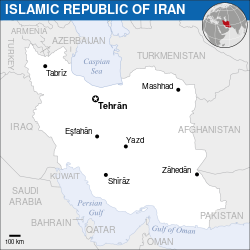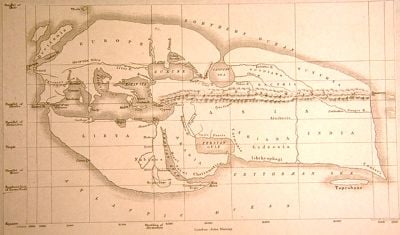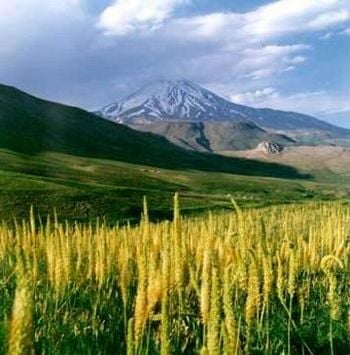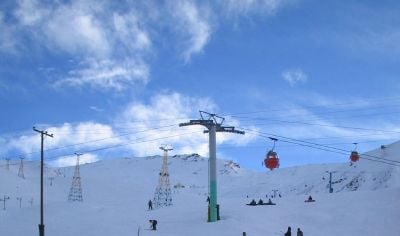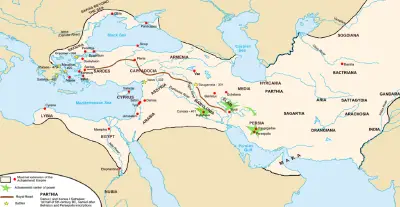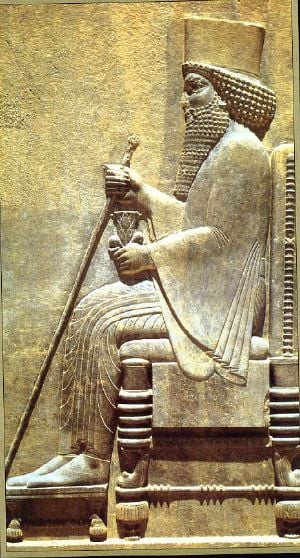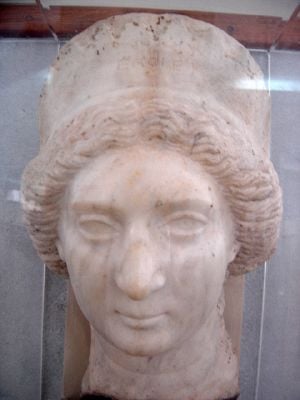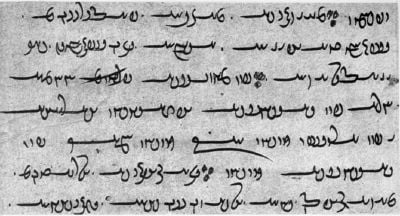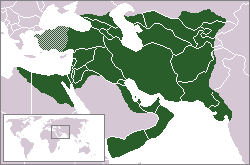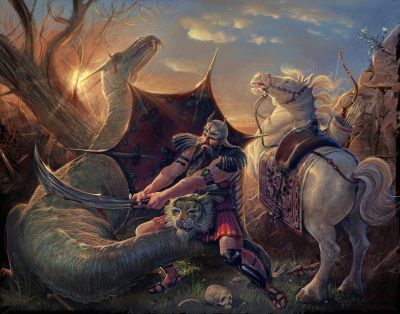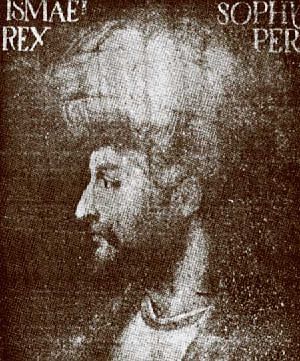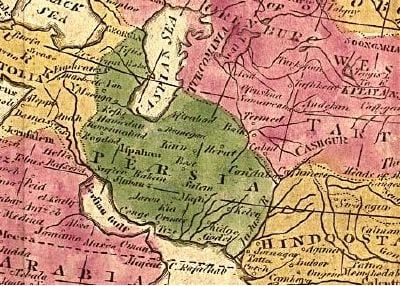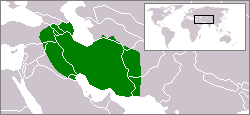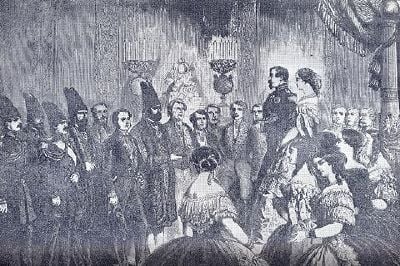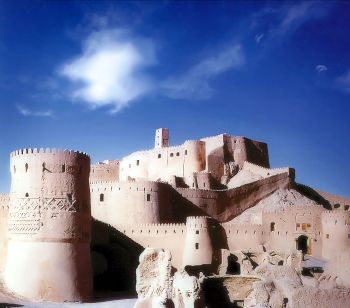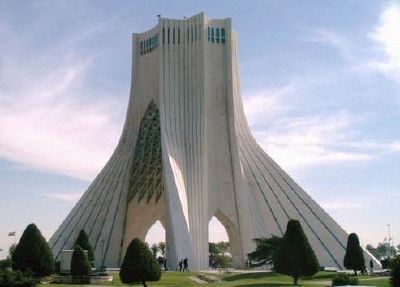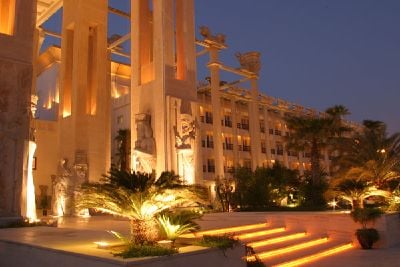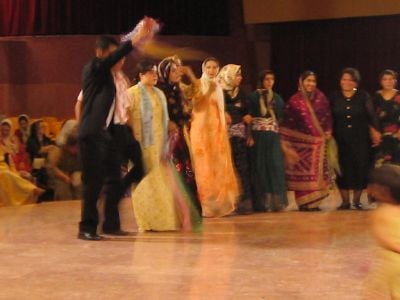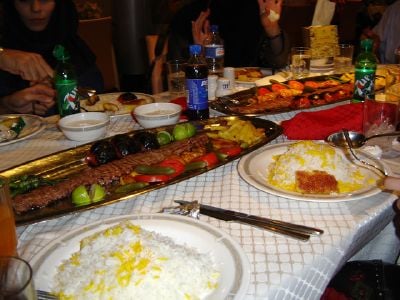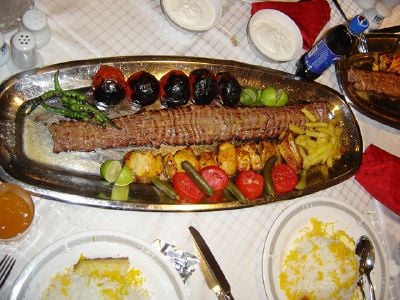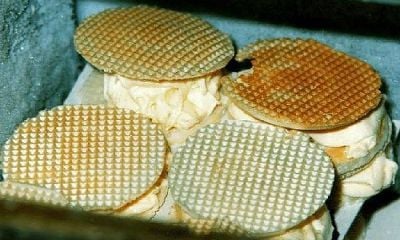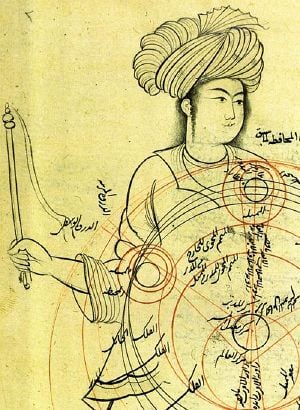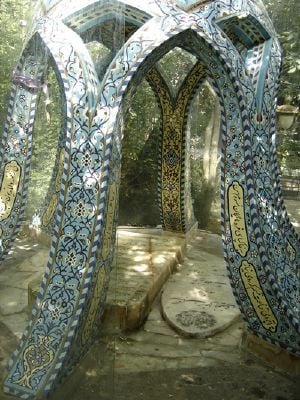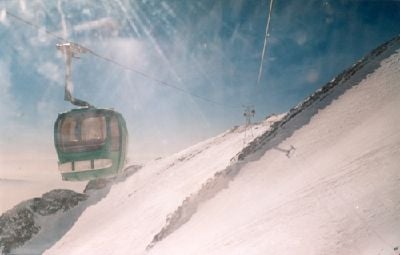Difference between revisions of "Iran" - New World Encyclopedia
Mary Anglin (talk | contribs) (→Major cities: remove coopyrighted) |
|||
| (131 intermediate revisions by 8 users not shown) | |||
| Line 1: | Line 1: | ||
| − | {{ | + | {{Copyedited}}{{Paid}}{{Approved}}{{Submitted}}{{Images OK}} |
| + | {{Infobox Country | ||
| + | | native_name ={{lang|fa|{{line-height|2|{{Nastaliq|جمهوری اسلامی ایران}}}}}} <br/>''Jomhuri-ye Eslāmi-ye Irān'' | ||
| + | | conventional_long_name = Islamic Republic of Iran | ||
| + | | common_name = Iran | ||
| + | | image_flag = Flag of Iran.svg | ||
| + | | image_coat = Coat of arms of Iran.svg | ||
| + | | symbol_type = Emblem | ||
| + | | image_map = Iran - Location Map (2013) - IRN - UNOCHA.svg | ||
| + | | official_religion = [[Shia Islam]] | ||
| + | | national_motto = استقلال. آزادی. جمهوری اسلامی <br/> <small>''Independence, Freedom, Islamic Republic</small> | ||
| + | | national_anthem = <br />[[National Anthem of Islamic Republic of Iran]]{{spaces|2}}<small>(official)</small><br/>{{lang|fa|''[[Ey Iran]]''}}{{spaces|2}}<small>(De facto)</small><br/><small>({{lang-fa|Oh Iran}})</small> | ||
| + | | capital = [[Tehran]] | ||
| + | | latd=35|latm=41|latNS=N|longd=51|longm=25|longEW=E | ||
| + | | largest_city = capital | ||
| + | | official_languages = [[Persian language|Persian]] | ||
| + | | languages_type = [[Spoken language]]s | ||
| + | | languages = [[Persian language|Persian]], [[Azerbaijani language|Azeri]], [[Assyrian Neo-Aramaic]], [[Armenian language|Armenian]], [[Kurdish language|Kurdish]], [[Lori dialects|Lori]], [[Balochi language|Balochi]], [[Gilaki language|Gilaki]], [[Mazandarani language|Mazandarani]], [[Arabic language|Arabic]], [[Turkmen language|Turkmen]] | ||
| + | | demonym = [[Demographics of Iran|Iranian]] | ||
| + | | Religion = [[Shia Islam]] | ||
| + | | government_type = [[Unitary state]], [[Islamic republic]] | ||
| + | | legislature = [[Islamic Consultative Assembly (Iran)|Islamic Consultative Assembly]] | ||
| + | | leader_title1 = [[Supreme Leader of Iran|Supreme Leader]] | ||
| + | | leader_name1 = {{nowrap|[[Ali Khamenei]]}} | ||
| + | | leader_title2 = [[President of Iran|President]] | ||
| + | | leader_name2 = {{nowrap|[[Ebrahim Raisi]]}} | ||
| + | | leader_title3 = [[Vice President of Iran|Vice President]] | ||
| + | | leader_name3 = {{nowrap|[[Mohammad Mokhber]]}} | ||
| + | | leader_title4 = [[Chief Justice]] | ||
| + | | leader_name4 = {{nowrap|[[Gholam-Hossein Mohseni-Ezhe'i]]}} | ||
| + | | sovereignty_type = Establishment history | ||
| + | | established_event1 = [[Median Empire]] | ||
| + | | established_date1 = 625 B.C.E. | ||
| + | | established_event2 = [[Safavid Empire]] | ||
| + | | established_date2 = 1501<ref>Andrew J. Newman, ''Safavid Iran: Rebirth of a Persian Empire'' (I.B. Tauris, 2008, ISBN 978-1845118303).</ref> | ||
| + | | established_event3 = [[Islamic Republic]] | ||
| + | | established_date3 = 1 April 1979 | ||
| + | | established_event4 = [[Constitution of the Islamic Republic of Iran|Current constitution]] | ||
| + | | established_date4 = 24 October 1979 | ||
| + | | established_event5 = [[1989 Iranian constitutional referendum|Latest amendment]] | ||
| + | | established_date5 = 28 July 1989 | ||
| + | | area_km2 = 1,648,195 | ||
| + | | area_sq_mi = 636,372 <!--Do not remove per [[WP:MOSNUM]]—> | ||
| + | | area_rank = 18th | ||
| + | | area_magnitude = 1 E12 | ||
| + | | percent_water = 0.7 | ||
| + | | population_estimate = 83,992,949<ref>[https://www.worldometers.info/world-population/iran-population/ Iran Population] ''Worldometer''. Retrieved June 22, 2021.</ref> | ||
| + | | population_estimate_year = 2019 | ||
| + | | population_estimate_rank = 17th | ||
| + | | population_density_km2 = 48 | ||
| + | | population_density_sq_mi = 124<!--Do not remove per [[Wikipedia:Manual of Style/Dates and Numbers]]—> | ||
| + | | population_density_rank = 162nd<!--Wiki source[?]—> | ||
| + | | GDP_PPP = {{decrease}} $1.007 trillion<ref name="IMFWEOIR">[https://www.imf.org/en/Publications/WEO/weo-database/2020/October/weo-report?c=512,914,612,614,311,213,911,314,193,122,912,313,419,513,316,913,124,339,638,514,218,963,616,223,516,918,748,618,624,522,622,156,626,628,228,924,233,632,636,634,238,662,960,423,935,128,611,321,243,248,469,253,642,643,939,734,644,819,172,132,646,648,915,134,652,174,328,258,656,654,336,263,268,532,944,176,534,536,429,433,178,436,136,343,158,439,916,664,826,542,967,443,917,544,941,446,666,668,672,946,137,546,674,676,548,556,678,181,867,682,684,273,868,921,948,943,686,688,518,728,836,558,138,196,278,692,694,962,142,449,564,565,283,853,288,293,566,964,182,359,453,968,922,714,862,135,716,456,722,942,718,724,576,936,961,813,726,199,733,184,524,361,362,364,732,366,144,146,463,528,923,738,578,537,742,866,369,744,186,925,869,746,926,466,112,111,298,927,846,299,582,487,474,754,698,&s=NGDPD,PPPGDP,NGDPDPC,PPPPC,&sy=2018&ey=2020&ssm=0&scsm=1&scc=0&ssd=1&ssc=0&sic=0&sort=subject&ds=.&br=1 World Economic Outlook Database, October 2020] ''International Monetary Fund''. Retrieved June 22, 2021.</ref> | ||
| + | | GDP_PPP_year = 2020 | ||
| + | | GDP_PPP_rank = 18th | ||
| + | | GDP_PPP_per_capita = {{decrease}} $11,963<ref name="IMFWEOIR"/> | ||
| + | | GDP_PPP_per_capita_rank = 66th | ||
| + | | GDP_nominal = {{increase}} $611 billion<ref name="IMFWEOIR"/> | ||
| + | | GDP_nominal_year = 2020 | ||
| + | | GDP_nominal_rank = 21st | ||
| + | | GDP_nominal_per_capita = {{increase}} $7,257<ref name="IMFWEOIR"/> | ||
| + | | GDP_nominal_per_capita_rank = 78th | ||
| + | | Gini = 42.0<ref>[https://data.worldbank.org/indicator/si.pov.gini Gini index (World Bank estimate) GINI index (World Bank estimate)] ''The World Bank''. Retrieved June 22, 2021.</ref><!--number only—> | ||
| + | | Gini_year = 2018 | ||
| + | | Gini_change = increase<!--increase/decrease/steady—> | ||
| + | | Gini_ref = | ||
| + | | Gini_rank = | ||
| + | | currency = [[Iranian rial|Rial]] (﷼) | ||
| + | | currency_code = IRR | ||
| + | | time_zone = [[Iran Standard Time|IRST]] | ||
| + | | utc_offset = 03:30 | ||
| + | | time_zone_DST = [[Iran Standard Time|Iran Daylight Time (IRDT)]] | ||
| + | | utc_offset_DST = 04:30 | ||
| + | | drives_on = right | ||
| + | | cctld = [[.ir]], [[ایران.]] | ||
| + | | calling_code = [[Telephone numbers in Iran|98]] | ||
| + | }} | ||
| + | |||
| + | |||
| + | '''Iran''' (ايران, ''Īrān''), officially the '''Islamic Republic of Iran''' (جمهوری اسلامی ايران, transliteration: ''Jomhūrī-ye Eslāmī-ye Īrān''), and formerly known as "Persia" in the West, is one of the world's oldest continuous major [[civilization]]s, and is one of the few states that comprise the [[Cradle of Humanity]]. | ||
| − | + | The history of Iran covers over four thousand years. Throughout history, it has been of great strategic importance because of its central location in [[Eurasia]]. Iran is significant in international [[politics]] due to its large supply of [[petroleum]] as well as its influence in the [[Middle East]] region. | |
| − | + | {{toc}} | |
| − | + | [[Cyrus the Great]] and [[Zoroastrianism]], both of which originated in this land, along with the flowering of thought in ninth-century Persia, each had a decisive impact on the progress of [[human]] history. | |
| − | |||
| − | |||
| − | |||
| − | |||
| − | |||
| − | |||
| − | |||
| − | |||
| − | |||
| − | |||
| − | |||
| − | |||
| − | |||
| − | |||
| − | |||
| − | |||
| − | |||
| − | |||
| − | |||
| − | |||
| − | |||
| − | |||
| − | |||
| − | |||
| − | |||
| − | |||
| − | |||
| − | |||
| − | |||
| − | |||
| − | |||
| − | |||
| − | |||
| − | |||
| − | |||
| − | |||
| − | |||
| − | |||
| − | |||
| − | |||
| − | |||
| − | |||
| − | |||
| − | |||
| − | |||
| − | |||
| − | |||
| − | |||
| − | |||
| − | |||
| − | |||
| − | |||
| − | |||
| − | |||
| − | |||
| − | |||
| − | |||
| − | |||
| − | |||
| − | |||
| − | |||
| − | |||
| − | |||
| − | |||
| − | |||
| − | |||
| − | |||
| − | |||
| − | |||
| − | |||
| − | |||
| − | |||
| − | |||
| − | |||
| − | |||
| − | |||
| − | |||
| − | |||
==Etymology== | ==Etymology== | ||
| − | [[Image: | + | [[Image:Iran.jpg|thumb|right|400px|Map of the world by Eratosthenes, circa 200 B.C.E. In antiquity, the names Ariana (Āryānā) and Persis were used to describe the region where modern-day Iran is found.]] |
| + | The official name of the nation is the ''Islamic Republic of Iran,'' but the noun ''Persia'' and the adjective ''Persian'' are still used in cultural contexts. | ||
| + | |||
| + | The ancient nation of Iran was known to the West as [[Persia]], due to the ancient Greek language name for Iran, ''Persis.'' The name ''Persia'' is used to describe the nation of Iran, its people, or its ancient empire. The Persians have called their country Iran/Iranshahr since the [[Sassanid dynasty|Sassanian period]], which started in 224 C.E. | ||
| + | |||
| + | The name ''Persia'' comes from a region in the south of Iran, called ''Fars'' or ''Pars'' in the Persian language. This region was the core of the original Persian Empire. | ||
| + | |||
| + | Westerners referred to the state as Persia until March 21, 1935, when [[Reza Shah Pahlavi]] formally asked the international community to call the country by its native name, Iran, which means ''Land of the [[Aryan]]s.'' Because of some Persian scholars' protests the government announced in 1959 that both ''Persia'' and ''Iran'' could be used. | ||
| + | |||
| + | ==Geography== | ||
| + | Iran is the seventeenth-largest country in the world. Its area roughly equals the size of the [[United Kingdom]], [[France]], [[Spain]], and [[Germany]] combined. Iran's area is approximately 636,300 square miles (1,648,000 square kilometers), of which 631,663 square miles (1,636,000 square kilometers) is land, and approximately 4,633 square miles (12,000 square kilometers) is water. | ||
| + | |||
| + | Iran borders [[Armenia]], [[Azerbaijan]] (including its [[Nakhichevan]] exclave) and [[Turkmenistan]] to the north, [[Afghanistan]] and [[Pakistan]] to the east, and [[Iraq]] and [[Turkey]] to the west. In addition, it borders the [[Persian Gulf]], across which lie [[Kuwait]], Iraq, [[Saudi Arabia]], [[Bahrain]], [[Oman]], [[Qatar]], and the [[United Arab Emirates]]. | ||
| + | |||
| + | [[Image:Damavand3.jpg|thumb|350px|left|Mount Damavand is Iran's highest point]] | ||
| + | Iran's central plateau is a [[tectonic plate]] that forms a basin surrounded by several tall, heavily eroded [[mountain]] ranges. The [[geology]] is highly unstable, creating frequent [[earthquake]]s. | ||
| + | |||
| + | Iran is one of the world's most mountainous countries; its landscape is dominated by rugged mountain ranges that separate various basins or plateaus from one another. The populous western part is the most mountainous, with ranges such as the [[Caucasus]], Zagros, and Alborz Mountains. The latter contains Iran's highest point, Mount Damavand at 18,386 feet (5604 meters) that is not only the country's highest peak but also the highest mountain on the [[Eurasia]]n landmass west of the Hindu Kush. | ||
| + | |||
| + | The eastern part consists mostly of [[desert]] basins like the saline Dasht-e Kavir, Iran's largest desert, located in the north-central portion of the country, and the Dash-e Lut, in the east, as well as some salt lakes. Mostly these deserts are uninhabited. | ||
| + | |||
| + | The only large plains are found along the coast of the [[Caspian Sea]] and at the northern end of the Persian Gulf, where Iran borders the mouth of the Arvand River. Smaller, discontinuous plains are found along the remaining coast of the Persian Gulf, the Strait of Hormuz, and the Sea of Oman. | ||
| + | |||
| + | Iran's [[climate]] is mostly arid or semi-arid, to subtropical along the Caspian coast. | ||
| + | |||
| + | On the northern edge of the country (the Caspian coastal plain), temperatures nearly fall below freezing and remain humid for the rest of the year. Summer temperatures rarely exceed 84°F (29°C). Annual precipitation is 27 inches (680mm) in the eastern part of the plain and more than 67 inches (1700mm) in the western part. | ||
| + | |||
| + | To the west, inhabitants in the Zagros Mountains basin experience lower temperatures, severe winters, sub-freezing average daily temperatures, and heavy snowfall. The eastern and central basins are arid, with less than eight inches (200mm) of [[rain]]. Average summer temperatures exceed 100°F (38°C). | ||
| + | |||
| + | The coastal plains of the Persian Gulf and Gulf of Oman in southern Iran have mild winters, and very humid and hot summers. The annual precipitation ranges from five to 14 inches (135 to 355mm). | ||
| + | |||
| + | More than one-tenth of the country is [[Forest|forested]]. The most extensive growths are found on the mountain slopes rising from the Caspian Sea, with stands of [[oak]], [[ash]], [[elm]], [[cypress]], and other valuable [[tree]]s. On the plateau proper, areas of scrub oak appear on the best-watered mountain slopes. Villagers cultivate orchards and grow the plane tree, [[poplar]], [[willow]], walnut, beech, [[maple]], and [[mulberry]]. Wild plants and shrubs spring from the barren land in the spring and afford pasturage, but the summer sun burns them away. | ||
| + | |||
| + | More than 2,000 [[plant]] [[species]] are grown in Iran. The land covered by Iran’s natural flora is four times that of Europe’s. | ||
| + | |||
| + | One of the most famous members of wildlife in Iran are the world's last surviving, [[endangered species|critically endangered]] Asiatic [[cheetah]], which today are found nowhere else but in Iran. Iran had lost all of its Asiatic [[lion]] and the now-[[extinction|extinct]] Caspian [[tiger]]s by the earlier part of the twentieth century. | ||
| + | [[Image:Dizin.jpg|thumb|400px|right|Dizin skiing resort, Iran]] | ||
| + | |||
| + | [[Bear]]s in the mountains, wild [[sheep]] and [[goats]], [[gazelle]]s, wild asses, wild [[pig]]s, [[panther]]s, and [[fox]]es abound. Domestic animals include sheep, goats, [[cattle]], [[horse]]s, water [[buffalo]], [[donkey]]s, and [[camel]]s. The [[pheasant]], [[partridge]], [[stork]], and [[falcon]] are native to Iran. | ||
| + | |||
| + | The Persian [[leopard]] is said to be the largest of all the subspecies of leopards in the world. Found throughout the Alborz and Zagros mountain ranges, as well as smaller ranges within the Iranian plateau, the leopard population is sparse, due to loss of habitat, loss of natural prey, and population fragmentation. | ||
| + | |||
| + | Natural hazards include periodic droughts, floods, dust storms, sandstorms, and earthquakes along the western border and in the northeast. | ||
| + | |||
| + | Environmental issues include: air [[pollution]], especially in urban areas, from vehicle emissions, refinery operations, and industrial effluents; deforestation; overgrazing; [[desertification]]; [[oil]] pollution in the [[Persian Gulf]]; wetland losses from drought; [[soil]] degradation (salination); inadequate supplies of potable water in some areas; and [[urbanization]]. | ||
| + | |||
| + | The capital city, [[Tehran]], had a metropolitan population of 7,314,000 in 2005. More than half of Iran's industry, including the manufacturing of [[automobile]]s, [[electronics]] and electrical equipment, military weaponry, [[textile]]s, sugar, cement, and chemical products, is based in Tehran. It is also a leading center for the sale of carpets and furniture. There is an oil refinery nearby. | ||
| + | |||
| + | ==History== | ||
| + | There are records of numerous ancient and technologically advanced civilizations on the Iranian plateau before the arrival of Aryan tribes from the north. [[Archaeology|Archaeological]] findings place knowledge of Persian [[prehistory]] at middle [[Paleolithic]] times (100,000 years ago). The earliest sedentary [[culture]]s date from 18,000 to 14,000 years ago. | ||
| + | |||
| + | Upper [[Paleolithic]] and [[Mesolithic]] populations lived in caves in the Zagros and Elburz mountains. The earliest civilizations in the region descended from the Zagros foothills, where they developed [[agriculture]] and animal husbandry, and established the first urban cultures in the [[Tigris-Euphrates]] basin in present-day Iraq. | ||
| + | |||
| + | In 6000 B.C.E. the world saw a fairly sophisticated agricultural society and proto-urban population centers. The southwestern part of Iran was part of the [[Fertile Crescent]] where most of humanity's first major crops were grown. Seven-thousand-year-old jars of [[wine]] were excavated in the Zagros Mountains, and ruins of 7,000-year-old settlements such as Sialk are further testament to this. Many dynasties have ruled Persia throughout the ages, including Teppe Sialk, Shahr-e Sukhteh, the Marlik civilization, the Luristan civilization, and the Mannaeans. Scholars and archaeologists are only beginning to discover the scope of the independent, non-Semitic Elamite and Jiroft civilizations. | ||
| + | |||
| + | ===Median and Achaemenian Empires=== | ||
| + | |||
| + | [[Image:Map achaemenid empire en.png|left|thumb|400px|The Achaemenian Empire (648–330 B.C.E.) at its greatest extent]] | ||
| + | The written history of (Iran) began in about 3200 B.C.E. with the Proto-Iranian civilization, followed by the Elamites. The Aryans (Indo-Iranians) arrived in the third and second millennium B.C.E. The Median dynasty (728–550 B.C.E.) is credited with founding Iran as a nation and empire, the largest of its day, until [[Cyrus the Great]] established a unified empire of the Medes and Persians leading to the Achaemenian Empire (648–330 B.C.E.). | ||
| − | + | Cyrus the Great created the Cyrus Cylinder, considered the first declaration of human rights. He was the first king whose name was suffixed with the word "great" and the first shah of Iran. Cyrus banned [[slavery]] in all conquered areas that became the [[Persian Empire]]. Cyrus' seminal ideas greatly influenced later human civilizations; Cyrus' principles of ruling—advocating love rather than fear—influenced the original [[United States|U.S.]] [[United States Constitution|Constitution]]. | |
| − | + | [[Image:Darius.jpg|thumb|300px|right|Stonecarving from Persepolis showing biblical figure Darius I the Great of Persia (r. 522–486 B.C.E.).]] | |
| + | After Cyrus' death, his son [[Cambyses]] ruled for seven years (531–522 B.C.E..E.) and continued his father's work of conquest, making significant gains in [[Egypt]]. A power struggle followed Cambyses' death and, despite his tenuous connection to the royal line, [[Darius I of Persia|Darius the Great]] was declared king (ruled 522–486 B.C.E.). He was to be arguably the greatest of the ancient Persian rulers. | ||
| − | + | Darius' first capital was at Susa, and he started the building program at [[Persepolis]]. He built a canal between the [[Nile River|Nile]] and the [[Red Sea]], a forerunner of the modern [[Suez Canal]]. He improved an extensive road system, including the Royal Road, a great highway stretching from Susa to Sardis with posting stations at regular intervals. | |
| − | |||
| − | + | Reforms took place under Darius. [[Coinage]], in the form of the ''daric'' ([[gold]] coin) and the ''shekel'' ([[silver]] coin) was introduced, and administrative efficiency was increased. The Old Persian language appears in royal inscriptions, written in a specially adapted version of cuneiform. | |
| − | |||
| − | + | Under Cyrus the Great and Darius the Great, the Persian Empire eventually became the largest and most powerful empire in human history up until that point. The Persian Empire represented the world's first global superpower and was based on a model of tolerance and respect for other [[culture]]s and [[religion]]s that few powers have matched. The [[Silk Road]], connecting Persia with [[China]] was significant not only for the development and flowering of the great civilizations of China, [[ancient Egypt]], [[Mesopotamia]], [[Persia]], [[India]] and [[Rome]], but also helped to lay the foundations of the modern world. | |
| − | |||
| − | + | [[Alexander the Great]] conquered Persia in 333 B.C.E. only to be followed shortly by two more vast and unified Iranian empires that shaped the pre-[[Islam]]ic identity of Iran and Central [[Asia]]: the [[Parthian Empire|Parthian]] (250 B.C.E.–226 C.E..) and [[Sassanid Empire|Sassanian]] (226–650 C.E.) dynasties. These latter dynasties defeated the [[Roman Empire]] at the height of its power on several occasions. | |
| − | |||
| − | |||
| − | == | + | ===Parthian Empire=== |
| − | + | [[Image:Parthian Queen Bust.jpg|thumb|300px|right|A bust from the National Museum of Iran of Queen Musa, wife of Phraates IV of Parthia.]] | |
| − | |||
| − | |||
| − | |||
| − | [[Image: | ||
| − | |||
| − | |||
| − | |||
| − | [[ | + | Parthia was led by the [[Arsacid dynasty]], which reunited and ruled over the Iranian plateau, after defeating the Greek [[Seleucid Empire]], beginning in the late third century B.C.E.., and intermittently controlled [[Mesopotamia]] between 150 B.C.E. and 224 C.E. It was the second native dynasty of ancient Iran (Persia). Parthia (mostly due to their invention of heavy cavalry) was the archenemy of the [[Roman Empire]] in the east; and it limited Rome's expansion beyond Cappadocia (central Anatolia). |
| + | |||
| + | The Parthian armies included two types of cavalry: the heavily armed and armored cataphracts, and the lightly armed but highly mobile mounted archers. For the Romans, who relied on heavy infantry, the Parthians were too hard to defeat, as both types of cavalry were much faster and more mobile than foot soldiers. On the other hand, the Parthians found it difficult to occupy conquered areas, as they were not skilled in siege warfare. | ||
| + | |||
| + | The Parthian empire lasted five centuries, until 224 C.E., when the last king was defeated by one of the empire's vassals, the Persians of the [[Sassanian dynasty]]. | ||
| − | + | ===Zoroastrianism=== | |
| − | [[Image: | + | [[Image:Bodleian_J2_fol_175_Y_28_1.jpg|right|thumb|400px|The [[Avestan]] (Old Iranian) language written in Din dabireh (literally ''religion script'') (scholarly consensus floats around 1000 B.C.E.).]] |
| − | |||
| − | |||
| − | |||
| − | + | Before the [[Islam]]ic conquest of Persia, [[Zoroastrianism]] was the state [[religion]] of the [[Sassanian Empire]] of Persia (224–651 C.E.), and played an important role in the earlier Median, Achaemenian, and Parthian dynasties. The Iranian [[prophet]] [[Zoroaster]] is considered by numerous scholars as the founder of the earliest religion based on revealed scripture. Many scholars point out that [[Judaism]] and subsequently, [[Christianity]] and Islam, have borrowed from Zoroastrianism in regards to the concepts of [[eschatology]], [[angel]]ology, and [[demonology]], as well as the fallen angel [[Satan]], as the ultimate agent of evil. Zoroastrian [[monotheism]] has had major influence on the religions of the [[Middle East]]ern monotheisms in adaptations of such concepts as heaven, hell, judgment day, and messianic figures. | |
| − | + | Despite its persecution of certain Christians during the fourth century, fifth-century Zoroastrian Iran became a haven for [[Nestorianism|Nestorian]]s fleeing Christian territories that supported the [[Council of Ephesus]]. As a result, the [[Assyrian Church of the East]] was formed. | |
| − | + | ===Sassanian Empire=== | |
| − | === | + | [[Image:Sassanid-empire-610C.E..png|thumb|right|400px|The [[Sassanian Empire]] at its greatest extent.]] |
| − | [[Image: | ||
| − | |||
| − | |||
| − | |||
| − | |||
| − | |||
| − | + | The first shah of the [[Sassanian Empire]], [[Ardashir I]], began reforming the country both economically and militarily. The empire's territory encompassed all of today's Iran, [[Iraq]], [[Armenia]], [[Afghanistan]], eastern parts of [[Turkey]], and parts of [[Syria]], [[Pakistan]], [[Caucasia]], [[Central Asia]], and [[Arabia]]. During Khosrau II's rule (590–628 C.E..), [[Egypt]], [[Jordan]], [[Palestine]] and [[Lebanon]] were annexed to the empire. The Sassanians called their empire ''Erānshahr'' (or ''Iranshæhr,'' "Dominion of the Aryans," i.e. of Iranians). The culture of the Sassanian period had influence reaching as far as western Europe. | |
| − | |||
| − | |||
| − | |||
| − | + | After roughly 600 years of conflict with the [[Roman Empire]], the war-exhausted Persians lost the Battle of al-Qādisiyyah (632 C.E.) in Hilla (present-day [[Iraq]]), paving way for the Islamic conquest of Persia. In that battle, the much larger [[Sassanian]] army had [[elephant]]s that terrified the Arab cavalry. In response, the Arab [[horse]]s were decorated in costume, frightening the Persian elephants. When an Arab warrior killed the lead elephant, other elephants fled, trampling numerous Persian fighters. At dawn of the fourth day, a sandstorm blew sand in the faces of the Persian soldiers, resulting in total disarray for the Sassanian army. | |
| − | |||
| − | |||
| − | |||
| − | |||
| − | |||
| − | |||
=== Islamic Iran === | === Islamic Iran === | ||
| − | + | [[Image:Canons of medicine.JPG|thumb|right|400px|A Latin copy of [[Avicenna]]’s ''Canon of Medicine,'' which was a standard medical text in [[Europe]] for seven centuries]] | |
| − | [[Image:Canons of medicine.JPG|thumb| | + | |
| − | [[Image: | + | Persia was conquered and incorporated into the Arab Empire, but Persia’s cultural richness filled a cultural vacuum in the pious but rough-and-ready Arab society. Persian [[literature]], [[philosophy]], [[medicine]], and [[art]] were about to become a major element of Muslim civilization from [[Cordoba]] to [[Delhi]], from [[Guinea]] to [[Samarkand]]. Persia held a position as a crossroads of the major "highways" of that period. |
| − | [[Persian | + | |
| − | Persia was | + | Persians took key roles in the new Islamic state. Persian Abu Moslem led troops from the Khorasan region to expel the [[Umayyad]]s from [[Damascus]] and helped the [[Abbasid]] [[caliph]]s conquer [[Baghdad]]. Arabs chose their "viziers" (ministers) from among Persians, and Persian governors acquired a certain amount of local autonomy. In the year 822, the governor of Khorasan, [[Tahir II]], proclaimed his independence and founded a new Persian dynasty of Thaheids. |
| + | |||
| + | During the ninth and tenth centuries, there was a resurgence of Persian national identity, against Arabization of [[Islam]] and Muslims. Epic poet [[Ferdowsi]]'s ''[[Shahnameh]]'' ''(Book of Kings)'', written in Persian, gave rise to a strong reassertion of Iranian national identity, and is in part responsible for the continued existence of Persian as a separate language. At that time, the Persian language was made the official language. | ||
| + | |||
| + | [[Image:Rostam.jpg|thumb|400px|right|''Rostam Slaying the Dragon'': Scene from ''Shahnameh'' by the epic poet Ferdowsi.]] | ||
| + | |||
| + | Scholars made significant advances in [[mathematics]], [[medicine]], [[astronomy]], [[engineering]], and many other fields during this period. Also during this time, [[Islamic philosophy]] developed and was often pivotal in scientific debates—key figures were usually scientists and philosophers. Persian scientists [[Ibn Sina]] (Avicenna) and [[Ibn Rushd]] helped save the works of [[Aristotle]], whose ideas came to dominate the non-religious thought of the Christian and Muslim worlds. Three speculative thinkers, [[al-Kindi]], [[al-Farabi]], and Abū ‘Alī, combined [[Aristotelianism]] and [[Neoplatonism]] with other ideas introduced through Islam. This Islamic Golden Age influenced the rise of European science, and contributed to the European Renaissance. | ||
| + | |||
| + | ===Turkish invasion=== | ||
| + | The Turks gradually infiltrated the Khorasan region along the Caspian coast. In the year 999 C.E., they dominated local Persian dynasties. [[Mahmud of Ghazni]] founded a vast empire. He even conquered northern [[India]] and helped to propagate in those lands the new Islamic-Persian civilization of which he was the principal protector. | ||
| + | |||
| + | The Saljuqs, his successors, asserted their domination from the [[Bosphorus]] to [[China]]. These sovereigns usually named Persians as viziers. | ||
| + | |||
| + | ===Mongol invasion=== | ||
| + | In 1218, [[Genghis Khan]] came down from the [[Altai Mountains]], marched through Iranian territories in Transoxiana to [[Khorasan]], occupied mainland Persia, then turned east through [[India]] and [[China]]. Holaku, one of the conqueror's grandsons, was left behind to reign over Persia. He soon became "Persianized." Settled in Maragheh (south of Tabriz), he called Persian men of letters to his court and encouraged the sciences and arts. | ||
| + | |||
| + | Yet another conqueror, Tamerlane (Teymur-e Lang), was to be seduced by the mirage of an empire of the Orient. In 1370, he entered Iran, and over a period of 30 years, he conquered [[Iraq]], [[Syria]], [[Anatolia]], [[Russia]], and India. He was about to invade China when he died in 1404. He chose [[Samarkand]] as his capital and his kingdom, while administered by Turkmen, it was of distinctively Persian culture. | ||
| + | |||
| + | ===Safavid Empire=== | ||
| + | [[Image:Shah Ismail I.jpg|thumb|right|300px|[[Shah Ismail I]], the founder of the Safavid Empire (1501–1736).]] | ||
| + | [[Image:Naghshe Jahan Square Isfahan modified.jpg|thumb|left|400px|Naghsh-i Jahan Square built in the Safavid era is one of the best examples of Persian [[architecture]]. It is still one of largest city squares in the world and the largest in western Asia.]] | ||
| + | |||
| + | In 1501, the [[Safavid Empire]] took control of Iran with Ismail I as its first ruler. To establish political legitimacy, the Safavid rulers claimed to be descended from Imam [[Ali ibn Abi Talib]] and his wife [[Fatima]] (the daughter of the Prophet [[Muhammad]]) through the seventh Imam Musa al-Kazim. To further legitimize his power, Ismail I added claims of royal Sassanian heritage after becoming shah. Persia underwent a revival under the Safavid dynasty (1502–1736). Iran's contemporary Shi’a character and significant segments of Iran's current borders take their origin from this era. | ||
| + | |||
| + | The greatest of the Safavid monarchs, Shah [[Abbas I the Great]] (1587–1629) came to power in 1587 at age 16. Abbas I first fought the Uzbeks, recapturing Herat and Mashhad in 1598. Then he turned against the [[Ottoman Empire|Ottomans]], recapturing [[Baghdad]], eastern [[Iraq]], and the Caucasian provinces by 1622. He dislodged the [[Portugal|Portuguese]] from [[Bahrain]] in 1602, and the [[England|English]] navy from Hormuz (1622), in the [[Persian Gulf]] (a vital link in Portuguese trade with [[India]]). He expanded commercial links with the [[British East India Company]] and the [[Dutch East India Company]]. The Safavid dynasty soon became a major power. Under their rule, Persian [[architecture]] flowered again. | ||
| + | |||
| + | [[Image:Persia1808.JPG|thumb|right|400px|By 1808, Persia had been reduced to a mere shadow of the [[Persian Empire]].]] | ||
| + | [[Image:LocationSafavid.PNG|left|thumb|400px|The Safavid Empire in 1512.]] | ||
| + | [[Image:Napoleon-Kashan.jpg|400px|thumb|Amin-o-Dowleh, head of the Persian royal envoy to the court of Napoleon III.]] | ||
| + | |||
| + | ===Afsharids, Zands and Qajars=== | ||
| + | A faltering Safavid court eventually gave way to the conqueror Nadir Shah (r. 1736–1747), founder of the Afsharid dynasty. He restored order and implemented policies for preserving the territorial integrity of Iran. In a short period, he conquered [[Afghanistan]] and [[India]]. The Zand dynasty, founded by Karim Khan, brought a period a peace for Iranians. Later came the Qajar dynasty (1795–1925). | ||
| + | |||
| + | By the seventeenth century, [[Europe]]an countries, including [[Portugal]], [[Great Britain]], [[Imperial Russia]], and [[France]], had started establishing colonial footholds in the region. Iran, as a result, lost sovereignty over many of its provinces to these countries via the Turkmanchai Treaty, Gulistan Treaty, and others. | ||
| + | |||
| + | ===Constitutional revolution=== | ||
| + | The Iranian Constitutional Revolution was sparked in December 1905, when two Iranian merchants were publicly beaten in [[Tehran]] for charging exorbitant prices. Protest against this by other merchants was joined by clerics. An uprising widened when government troops entered a [[mosque]] to disperse protesters. In a scuffle in early 1906 the government killed a descendant of the prophet [[Muhammad]], and a large number of clergy sought sanctuary in the holy city Qom. | ||
| + | |||
| + | In the summer of 1906 approximately 12,000 men camped out in the gardens of the British Embassy. It was there that the demand for a parliament was born, the goal of which was to limit the power of the shah. In August 1906, Mozaffareddin Shah agreed to allow a parliament, and in the fall, the first elections were held. The first Majlis (parliament) was convened on October 7, 1906. | ||
| + | |||
| + | The revolution marked the beginning of the end of Iran's [[Feudalism|feudalistic]] society and led to the establishment of a parliament. The revolution was the first event of its kind in the [[Middle East]], and opened the way for cataclysmic change in [[Persia]], heralding the modern era. | ||
| + | |||
| + | ===Oil discovery=== | ||
| + | The discovery of [[petroleum|oil]] in 1908 by the [[United Kingdom|British]] in Khuzestan spawned intense renewed interest in Persia by the British Empire and the Anglo-Iranian Oil Company (later BP). Control of Persia remained contested between the United Kingdom and [[Russia]], in what became known as the Great Game, and codified in the Anglo-Russian Convention of 1907, which divided Persia into spheres of influence. | ||
| − | + | ===Pahlavi dynasty=== | |
| − | |||
| − | + | In 1921, [[Reza Khan]] (later Reza Shah Pahlavi), an officer in Iran's only military force, the Persian Cossack Brigade, used his troops to support a coup against the government of the Qajar dynasty. In 1925, a specially convened assembly deposed Ahmad Shah Qajar, the last ruler of the Qajar dynasty, and named Reza Khan, who earlier had adopted the surname Pahlavi, as the new shah. | |
| − | |||
| − | |||
| − | + | Reza Shah had ambitious plans for modernizing Iran. He sent hundreds of Iranians, including his son, to [[Europe]] for training. During 16 years from 1925 and 1941, Reza Shah's numerous development projects transformed Iran into an urbanized country. [[Public education]] progressed rapidly, and a professional middle class and an industrial working class emerged. By the mid-1930s Reza Shah's dictatorial style of rule caused dissatisfaction among some groups, particularly the clergy who opposed his reforms. | |
| − | + | Reza Shah tried to avoid involvement with [[United Kingdom|Britain]] and the [[Soviet Union]]. Even though many of his development projects required foreign technical expertise, he avoided awarding contracts to British and Soviet companies. Although Britain, through its ownership of the [[Anglo-Iranian Oil Company]], controlled Iran's oil resources, Reza Shah got technical help from [[Germany]], [[France]], [[Italy]], and other [[Europe]]an countries. This caused a problem for Iran after 1939, when Germany and Britain became enemies in [[World War II]]. Reza Shah proclaimed Iran as a neutral country. Britain demanded that Iran expel all German citizens, but Reza Shah refused. | |
| − | |||
| − | === | + | ===Second World War=== |
| − | + | Following [[Germany]]'s invasion of the [[Soviet Union]] in June 1941, [[United Kingdom|Britain]] and the Soviet Union, who became allies, saw the newly opened [[Trans-Iranian Railroad]] as a route to transport supplies from the [[Persian Gulf]] to the Soviet region. In August 1941, because Reza Shah refused to expel Germans, Britain and the Soviet Union invaded Iran, arrested him, and sent him into [[exile]], taking control of Iran's communications and [[railroad]]. | |
| − | |||
| − | |||
| − | |||
| − | |||
| − | + | In 1942, the [[United States]], an ally of Britain and the Soviet Union, sent a military force to help maintain and operate sections of the railroad. The British and Soviet authorities allowed Reza Shah's system of government to collapse, and permitted Reza Shah's son, Mohammad Reza Pahlavi, to succeed to the throne. | |
| − | |||
| − | |||
| − | |||
| − | |||
| − | |||
| − | |||
| − | |||
| − | + | In January 1942, British and Soviet authorities agreed to respect Iran's independence and to withdraw their troops within six months of the war's end. In 1945, the Soviet Union delayed leaving Iran's northwestern provinces of East [[Azerbaijan]] and West Azerbaijan, where Soviet-supported autonomy movements had developed. The Soviet Union withdrew its troops in May 1946, but tensions continued. This episode helped precipitate the [[Cold War]], the post-war rivalry between the United States and the Soviet Union and their allies. | |
| − | |||
| − | |||
| − | |||
| − | The | + | ===The Cold War=== |
| − | + | [[File:Mohmmad,Mosaddegh2 (cropped).jpg|thumb|right|300px|Dr. Mohammad Mossadegh, founder of Iran's first [[democracy|democratic]] government, overthrown in a [[Central Intelligence Agency|CIA]]-backed coup in 1953]] | |
| − | + | In 1951, a pro-[[democracy|democratic]] nationalist, Dr. Mohammed Mossadegh, was elected prime minister. Mossadegh alarmed the West by nationalizing the Anglo-Iranian Oil Company (later British Petroleum, BP) that had controlled the country's oil reserves. [[United Kingdom|Britain]] immediately [[embargo]]ed Iran. | |
| − | |||
| − | + | Members of the British Intelligence Service invited the [[United States]] to join them in covertly overthrowing Mossadegh. United States President [[Harry S. Truman]] refused, but [[Dwight D. Eisenhower]] agreed, and authorized the [[Central Intelligence Agency|CIA]] to take the lead in overthrowing Mossadegh and supporting a U.S.-friendly monarch. Agents were hired to facilitate violence; and, as a result, protests broke out across the nation. Anti- and pro-monarchy protestors clashed, leaving 300 dead. The operation triggered a coup, and within days, pro-Shah tanks stormed the capital and bombarded the prime minister's residence. Mossadegh surrendered, and was arrested on August 19, 1953. He was tried for [[treason]], and jailed for three years. | |
| − | |||
| − | + | With strong support from the United States and the United Kingdom, Shah Mohammad Reza Pahlavi further modernized Iranian industry, but crushed all political opposition with his intelligence agency, SAVAK. Ayatollah [[Ruhollah Khomeini]] denounced the Shah's White Revolution. Khomeini, who was popular in religious circles, was jailed for 18 months. After his release in 1964, Khomeini criticized the United States government. Khomeini was exiled, first to [[Turkey]] and then to [[Iraq]]. | |
| − | + | ===Islamic Revolution=== | |
| + | Protests against the shah increased in 1979, culminating in the [[Iranian Revolution]]. The Shah fled, and [[Ruhollah Khomeini|Khomeini]] returned from [[exile]] on February 1, 1979. On February 11, Khomeini declared a provisional government led by Prime Minister Mehdi Bazargan, and on March 30 to March 31, asked all Iranians to vote in a referendum on establishing an [[Islamic republic]]. Over 98 percent of Iranians supported an Islamic republic. | ||
| − | + | Iranian students seized U.S. embassy personnel on November 4, 1979, labeling the embassy a "den of spies" and accused its personnel of being [[Central Intelligence Agency|CIA]] agents trying to overthrow the revolutionary government, as the CIA had done to Mohammad Mossadegh in 1953. | |
| − | + | Khomeini supported the embassy takeover, a move that only increased his popularity among the revolutionaries. Despite U.S. President [[Jimmy Carter]]'s attempts at negotiating and rescuing the hostages, in what became known as the [[Iran hostage crisis]], Iran refused to release them and threatened to put them on trial for [[espionage]]. The students demanded the handover of the shah in exchange for the hostages. This exchange never took place. After 444 days of captivity, embassy employees were allowed to return to the United States. | |
| − | |||
| − | |||
| − | |||
| − | |||
| − | + | === Iran-Iraq War === | |
| + | [[image:Saddam_rumsfeld.jpg|thumb|right|400px|Donald Rumsfeld meeting [[Saddam Hussein]] in 1983. Rumsfeld visited again on March 24, 1984, the same day the [[UN]] released a report that [[Iraq]] had used mustard gas and tabun nerve agent against Iranian troops.]] | ||
| − | [[ | + | Meanwhile, [[Iraq]]i leader [[Saddam Hussein]] decided to take advantage of perceived disorder in the wake of the [[Iranian Revolution]]. The once-strong Iranian military had been disbanded, and with the shah ousted, Saddam wanted to position himself as the new strongman of the [[Middle East]]. He also sought to expand Iraq's access to the [[Persian Gulf]] by acquiring Khuzestan, which had a substantial [[Arab]] population and rich [[petroleum|oil]] fields, and the islands of [[Abu Musa]] and the [[Greater and Lesser Tunbs]]. |
| − | + | On September 22, 1980, the Iraqi army invaded Iran at Khuzestan, taking revolutionary Iran by surprise. Although Iraqi forces made early advances, by 1982, Iranian forces pushed the Iraqi army back into Iraq. [[Ruhollah Khomeini|Khomeini]] refused a [[cease-fire]] from Iraq, demanding huge reparation payments, an end to Saddam's rule, and that Saddam be tried for [[crimes against humanity]]. Khomeini also sought to export his Islamic revolution into Iraq, especially on the majority Shi'a Arabs there. The war continued until 1988, when Khomeini accepted a truce mediated by the [[United Nations]]. | |
| − | + | Iraq was financially backed by [[Egypt]], the Arab countries of the [[Persian Gulf]], the [[Soviet Union]] and the [[Warsaw Pact]] states, the [[United States]] (beginning in 1983), [[France]], the [[United Kingdom]], [[Germany]], [[Brazil]], and the [[People's Republic of China]] (which also sold weapons to Iran). Iran's principal allies were [[Syria]], [[Libya]], and [[North Korea]]. | |
| − | + | Tens of thousands of Iranian civilians and military personnel were killed when Iraq used chemical weapons. The total Iranian casualties of the war were estimated to be anywhere between 500,000 and 1,000,000. | |
| − | |||
| − | The | + | ===Invasions=== |
| − | + | The [[Soviet Union|Soviet]] invasion of [[Afghanistan]] brought some three million Afghan refugees to Iran. In 1989, Khomeini died and was succeeded by Ayatollah Ali Khamenei. The presidency was soon filled by [[Ali Akbar Rafsanjani]], who sought improved relations with Western nations, diminishing the influence of revolutionary factions, and embarked on a military build-up. An earthquake hit northern Iran on June 21, 1990, killing nearly 40,000 people. | |
| − | |||
| − | |||
| − | |||
| − | |||
| − | |||
| − | + | When [[Iraq]] invaded [[Kuwait]] in August 1990, Iran adhered to international sanctions against Iraq. However, Iran condemned the use of U.S.-led coalition forces against Iraq during the [[Persian Gulf War]] (1991). As a result of the war and its aftermath, more than one million [[Kurds]] crossed the Iraqi border into Iran as refugees. | |
| − | |||
| − | |||
| − | + | Rafsanjani was reelected president in 1993. The [[United States]] suspended all trade with Iran in 1995, accusing Iran of supporting [[terrorism|terrorist]] groups and attempting to develop [[nuclear weapon]]s. In 1997, Mohammad Khatami, a moderately liberal [[Muslim]] cleric, was elected president. Several [[European Union]] countries began renewing economic ties with Iran in the late 1990s. In 1999, as new curbs were put on a free press, pro-[[democracy]] student demonstrations erupted, followed by counter demonstrations by conservatives. | |
| − | |||
| − | |||
| − | |||
| − | |||
| − | + | Reformers won about two thirds of the seats in the February 2000 parliamentary elections, but conservative elements in the government closed the reformist press, and attempts to repeal restrictive press laws were forbidden by Khamenei. Despite these conditions, President Khatami was overwhelming reelected in June, 2001. | |
| − | |||
| − | + | On January 29, 2002, U.S. President [[George W. Bush]] labeled Iran, along with [[Iraq]] and [[North Korea]] as an "[[Axis of evil]]." The speech sparked demonstrations across Iran. Tensions with the United States increased after the American invasion of Iraq in March 2003, as U.S. officials continued to denounce Iran for allegedly developing nuclear weapons. In October 2003, however, Iran agreed to tougher international inspections of its nuclear installations. | |
| − | + | An earthquake, centered on [[Bam]] in southeast Iran, killed more than 26,000 people in December 2003. | |
| − | |||
| − | |||
| − | + | ===Nuclear disputes=== | |
| + | In mid-2004, Iran began resuming the processing of nuclear fuel, saying that negotiations with [[European Union]] nations had failed to bring the promised access to the advanced nuclear technology. The United States said that the processing of nuclear fuel would give Iran the capability to develop [[nuclear weapon]]s. The International Atomic Energy Agency (IAEA) said that there was no evidence that Iran was seeking to develop such arms, but also called for Iran to abandon its plans to produce enriched [[uranium]]. In November 2004, Iran agreed to suspend uranium enrichment, but said that it would not be held to the suspension if the negotiations with EU nations failed. | ||
| − | + | The presidential election in June 2005 was won by the hard-line conservative mayor of [[Tehran]], [[Mahmoud Ahmadinejad]], who ran on a populist, anti-corruption platform. Ahmadinejad's victory gave conservatives control of all branches of Iran's government. | |
| − | Iran | + | After Iran resumed converting raw uranium into gas in August 2005, a necessary step for enrichment, the IAEA passed a resolution that accused Iran of failing to comply with the Nuclear Non-proliferation Treaty and called for the agency to report Iran to the [[United Nations|UN]] [[United Nations Security Council|Security Council]]. |
| + | |||
| + | In October 2005, Ahmadinejad held a conference titled "The World without [[Zionism]]," where he said he hoped the Zionist regime occupying [[Jerusalem]], would collapse. The Western media falsely interpreted Ahmadinejad’s speech as calling for [[genocide]] and a controversial translation of Ahmadinejad’s speech was that Ahmadinejad was calling for "Israel to be wiped off the map." Further dialogue surrounding this speech concludes that Admadinejad and Iran were calling not for the genocide of Israel, but for the formation of one state with Israeli and Palestinian agreement and cooperation. | ||
| + | |||
| + | In February, 2006, the IAEA voted to report Iran to the United Nations Security Council. In response, Iran resumed uranium enrichment and ended surprise IAEA inspections and surveillance of its nuclear facilities. The Security Council called for Iran to suspend its nuclear research program in 30 days, but the statement left unclear what, if any, response there would be if Iran refused. On April 11, 2006, Iranian President Mahmoud Ahmadinejad announced that Iran had successfully enriched uranium. | ||
| + | |||
| + | The enrichment program caused the nations involved, [[China]], [[France]], [[Germany]], [[Russia]], the [[United States]], and the nations of the EU, to refer the issue back to the Security Council in July 2006. The council set an August 31 deadline for Iran to stop enrichment, but Iran insisted it would continue its program and ignored the deadline. | ||
| + | |||
| + | On May 8, 2006, Ahmadinejad sent a personal letter to U.S. President [[George W. Bush]] to propose "new ways" to end Iran's nuclear dispute. It was the first direct contact between the American and Iranian heads of state since April 9, 1980. | ||
| + | |||
| + | On December 23, 2006, the [[United Nations Security Council]] unanimously passed Resolution 1737, which imposed sanctions against Iran for failing to stop its uranium enrichment program following Resolution 1696. | ||
==Government and politics== | ==Government and politics== | ||
| − | + | [[Image:Arge Bam Arad edit.jpg|thumb|350px|The [[Arg-e Bam]] citadel, built before 500 B.C.E.]] | |
| − | + | The political system of the Islamic Republic of Iran is based on the 1979 constitution called the ''Qanun-e Asasi'' ''(Fundamental Law)''. The system comprises several intricately connected governing bodies. | |
| − | + | ||
| − | === | + | ===Governing bodies=== |
| − | + | The '''Supreme Leader''' of Iran is responsible for general policies, is commander-in-chief of the armed forces, controls [[military intelligence]], and has sole power to declare [[war]]. He appoints judiciary heads, state [[radio]] and [[television]] heads, [[police]] and military commanders, and six of the 12 members of the Council of Guardians. The Assembly of Experts elects and dismisses the supreme leader on the basis of qualifications and popular esteem, and is responsible for supervising the supreme leader. | |
| − | + | ||
| − | The Supreme Leader of Iran is responsible for | + | The '''President''' is the highest state authority, and is elected by universal suffrage for a term of four years. The Council of Guardians approves presidential candidates. The president implements the constitution and exercises executive powers, except for matters directly related to the supreme leader. The president appoints and supervises the Council of Ministers, coordinates government decisions, and selects government policies to be placed before the legislature. Eight vice-presidents serve under the president, as well as a cabinet of 21 ministers, who must all be approved by the legislature. The executive branch does not control the armed forces. Although the president appoints the ministers of intelligence and defense, the president must obtain approval from the supreme leader before presenting them to the legislature. |
| − | + | ||
| − | + | The '''Council of Guardians''' comprises 12 jurists including six appointed by the supreme leader; the remaining six are appointed by parliament (Majles). If a law is deemed incompatible with the constitution or ''[[Sharia]]'' (Islamic law), it is referred back to parliament for revision. | |
| − | + | ||
| − | + | The '''Expediency Council''' has the authority to mediate disputes between parliament and the Council of Guardians, and serves as an advisory body to the supreme leader, making it one of the most powerful governing bodies in the country. | |
| − | + | ||
| − | The | + | The '''Majlis of Iran''' (Islamic Consultative Assembly), or parliament, is comprised of 290 members elected for four-year terms. The Majlis drafts legislation, ratifies international treaties, and approves the national budget. All Majlis candidates and all legislation from the assembly must be approved by the Council of Guardians. |
| − | + | ||
| − | + | The supreme leader appoints the head of the '''judiciary,''' who in turn appoints the head of the Supreme Court and the chief public prosecutor. Public courts deal with civil and criminal cases, and "revolutionary courts" deal with crimes against national security. The decisions of the revolutionary courts cannot be appealed. The Special Clerical Court handles crimes committed by clerics, functions independently of the regular judicial framework, and is accountable only to the supreme leader. The court's rulings are final and cannot be appealed. | |
| − | The | + | |
| − | + | [[Image:Azadi1.jpg|thumb|400px|After the revolution, Shahyad Tower was renamed to [[Azadi Tower]] (Freedom Tower)]] | |
| − | + | The '''Assembly of Experts,''' which meets for one week annually, comprises 86 "virtuous and learned" clerics elected by adult suffrage for eight-year terms. The Council of Guardians determines candidates' eligibility. The assembly elects the supreme leader and has the constitutional authority to remove the supreme leader from power at any time. The assembly has never been known to challenge any of the supreme leader's decisions. | |
| − | + | ||
| − | + | '''City and village councils''' are elected by public vote to four-year terms. Councils elect mayors, supervise municipalities, and implement social, economic, constructive, cultural, educational, and other welfare affairs. | |
| − | + | ||
| − | The | + | ===Politics=== |
| − | + | Formal political parties are relatively new in Iran, and most conservatives still prefer to work through political pressure groups rather than parties. Often political parties or groups are formed prior to elections and disbanded soon thereafter. | |
| − | [[Image:Azadi1.jpg|thumb| | + | |
| − | + | A loose pro-reform coalition called the Second Khordad Front, which includes political parties as well as less formal pressure groups and organizations, achieved considerable success at elections to the sixth Majles in early 2000. The coalition includes: Islamic Iran Participation Front (IIPF), Executives of Construction Party (Kargozaran), Solidarity Party, Islamic Labor Party, Mardom Salari, Mojahedin of the Islamic Revolution Organization (MIRO), and Militant Clerics Society (Ruhaniyun). The coalition participated in the seventh Majles elections in early 2004. | |
| − | The | + | |
| − | + | The Islamic Revolutionary Party (IRP) was Iran's sole political party until its dissolution in 1987. Groups that support the Islamic republic include Ansar-e Hizballah, Muslim Students Following the Line of the Imam, Tehran Militant Clergy Association (Ruhaniyat), Islamic Coalition Party (Motalefeh), and Islamic Engineers Society. Active pro-reform student groups include the Office of Strengthening Unity (OSU). Opposition groups include Freedom Movement of Iran, the National Front, and Marz-e Por Gohar. | |
| − | + | ||
| − | + | Various armed political groups that have been repressed include Mujahidin-e Khalq Organization (MEK or MKO), People's Fedayeen, Democratic Party of Iranian Kurdistan (KDPI), and Komala. | |
| − | + | ||
| − | + | Iran is divided into 30 provinces ''(ostanha)''. | |
| − | == | + | |
| − | + | ===Military=== | |
| − | + | Iran has two kinds of armed forces: the regular forces and the Islamic Revolutionary Guards Corps, totaling about 545,000 personnel. Both fall under the command of the ministry of defense. The regular armed forces have an estimated 420,000 troops in three branches: ground forces (350,000 troops), navy (18,000 sailors), and air force (52,000 airmen). The Islamic Revolutionary Guards Corps has an estimated 125,000 personnel in five branches: Qods force (special forces), Basij (paramilitary), navy, air force, and the ground forces. | |
| − | Iran | + | |
| − | + | Iran also has a paramilitary volunteer force called the Basij, which includes about 90,000 full-time, active-duty uniformed Basij members, up to 300,000 reservists, and a further 11 million men and women who could be mobilized. | |
| − | + | ||
| − | + | Iran's military capabilities are kept largely secret. In the early 2000s, official announcements have highlighted the development of weapons such as Fajr-3 (MIRV) missile, Hoot, Kowsar, Fateh-110, Shahab-3, and a variety of unmanned aerial vehicles. | |
| − | |||
| − | |||
| − | |||
| − | |||
| − | |||
| − | |||
| − | |||
| − | |||
| − | |||
| − | |||
| − | |||
| − | |||
| − | |||
| − | |||
| − | |||
| − | |||
| − | |||
| − | |||
| − | |||
| − | |||
| − | |||
| − | |||
| − | |||
| − | |||
| − | |||
| − | |||
| − | |||
| − | |||
| − | |||
| − | |||
| − | |||
| − | 30 | ||
| − | |||
| − | == | ||
| − | |||
| − | |||
| − | |||
| − | Iran is | + | Iran is a founding member of the [[United Nations]], the [[Non-Aligned Movement]] (NAM), the [[Organization of the Islamic Conference]] (OIC), the [[Organization of the Petroleum Exporting Countries]] (OPEC), and the [[Economic Cooperation Organization]] (ECO). |
| − | |||
| − | |||
| − | |||
| − | |||
| − | |||
==Economy== | ==Economy== | ||
| − | + | [[Image:Dariushhotel2.jpg|thumb|400px|Kish Island is a free-trade zone, which is fast becoming a major tourist destination.]] | |
| − | [[Image: | + | |
| − | + | Iran's economy is marked by a bloated, inefficient state sector, over-reliance on the [[petroleum|oil]] sector, and statist policies that create distortions throughout the nation. Most economic activity is controlled by the state. Private sector activity is typically small-scale workshops, farming, and services. | |
| − | [[ | + | |
| − | Iran's | + | Relatively high oil prices in recent years have enabled Iran to amass nearly $60-billion in foreign exchange reserves, but have not eased high unemployment and [[inflation]]. The proportion of the economy devoted to the development of weaponry remains a contentious issue with leading Western nations. |
| + | |||
| + | In the early twenty-first century, the service sector contributed the largest percentage of the GDP, followed by industry ([[mining]] and [[manufacturing]]) and [[agriculture]]. About 45 percent of the government's budget came from [[oil]] and [[natural gas]] revenues, and 31 percent came from [[tax]]es and fees. | ||
| + | |||
| + | In 2004, the GDP was estimated at $542 billion of purchasing power parity, or $8,100 per capita, 71st on a list of 181 nations. Because of these figures and the country’s diversified but small industrial base, the [[United Nations]] classified Iran's economy as semi-developed. | ||
| + | |||
| + | Over 20 percent of Iran's GDP is controlled by bonyads, which are Iranian charitable trusts. Initially set up during the time of the shah of Iran, they were used to funnel money into the shah's personal coffers. After the [[Iranian Revolution]], the bonyads were used to redistribute oil income among the poor and the families of [[martyr]]s. | ||
| + | |||
| + | Iran is [[OPEC]]'s second-largest oil producer, exporting over three million barrels of oil per day. Moreover, it holds 10 percent of the world's confirmed oil reserves. Iran also has the world's second-largest natural gas reserves (after [[Russia]]). | ||
| + | |||
| + | The administration continues to follow market reform plans and diversify Iran's oil-reliant economy. It is attempting to do this by investing revenues in areas like [[automobile]]s, manufacturing, aerospace industries, consumer [[electronics]], [[petrochemicals]], and nuclear technology. Iran has developed [[biotechnology]], [[nanotechnology]], and [[pharmaceuticals]] industries. | ||
| + | |||
| + | Iranian budget deficits have been a chronic problem, in part due to large-scale state subsidies (totaling some $30 billion per year) that include foodstuffs and especially gasoline. | ||
| − | + | Since the late 1990s, Iran has increased its economic cooperation with other developing countries, including [[Syria]], [[India]], [[Cuba]], [[Venezuela]], and [[South Africa]]. Iran is also expanding its trade ties with [[Turkey]] and [[Pakistan]] and shares with its partners the common goal of creating a single economic market in West and Central [[Asia]], much like the [[European Union]]. | |
| − | |||
| − | + | Export commodities include [[petroleum]], chemical and petrochemical products, [[fruit]]s and [[nut]]s, and carpets. Export partners include [[Japan]], [[China]], [[Italy]], [[South Korea]], Turkey, [[Netherlands]], [[France]], South Africa, and [[Taiwan]]. | |
| − | + | ||
| − | + | Import commodities include industrial raw materials and intermediate goods, capital goods, foodstuffs and other consumer goods, technical services, and military supplies. Import partners include [[Germany]], [[United Arab Emirates]], China, Italy, France, South Korea, and Russia. | |
| − | |||
| − | |||
| − | |||
==Demographics== | ==Demographics== | ||
| − | + | Iran's population increased dramatically during the latter half of the twentieth century. More than two-thirds of the population is under the age of 30, and nearly one-quarter of its people are 15 years of age or younger. The Iranian diaspora is estimated at over four million people who emigrated to [[North America]], [[Europe]], [[South America]], and [[Australia]], mostly after the [[Iranian Revolution]] in 1979. Iran also hosts one of the largest [[refugee]] populations in the world, with more than one million refugees, mostly from [[Afghanistan]] and [[Iraq]]. | |
| − | [[ | + | |
| − | [[ | + | ===Ethnicity=== |
| − | [[ | + | The majority of Iranians are Persian, with other ethnic groups including Azeris, Gilaki and Mazandarani, Kurds, [[Arab]]s, Baluchi, Lurs, Turkmens, Qashqai, Armenians, Persian Jews, Georgians, Assyrians, Circassians, Tats, Pashtuns, and others making up the rest of the population. There is little ethnic conflict, although the Kurds, living on Iran's western border, have pushed for autonomy. [[Nomad]]ic tribal groups in the southern and western regions have been difficult to control. The Arab population of the southwestern province of Khuzestan has aspired to break away from Iran. |
| − | + | ||
| + | ===Religion=== | ||
| + | Ninety percent of Iranian people belong to the [[Shi'a]] branch of [[Islam]], the official state religion, and about 8 percent, mainly Kurds, belong to the [[Sunni]] branch. The remaining 2 percent are non-Muslim religious minorities, mainly [[Baha’i Faith|Bahá'ís]], [[Mandeanism|Mandeans]], [[Hinduism|Hindus]], [[Zoroastrianism|Zoroastrians]], [[Judaism|Jews]], and [[Christianity|Christians]]. The latter three minority religions are officially recognized, and have reserved seats in the Majles' (Parliament). However the Bahá'í Faith, Iran's largest religious minority, is not officially recognized, and since the 1979 revolution, persecution has increased with executions and access to higher education denied. | ||
| + | |||
| + | The state religion of “Ithnaashara,” or Twelver Shi'ism, was established by the [[Safavid Dynasty]] in the seventeenth century. Shi'a Muslims revere the descendants of [[Fatimah]], daughter of the prophet [[Muhammad]], and her husband, [[Ali ibn Abi Talib|Ali]], Muhammad's cousin. Twelve Imams are recognized, all of whom were [[martyr]]ed except the twelfth, Muhammad al-Mahdi, who disappeared, but it is believed that he will return at the end of time with [[Jesus of Nazareth|Jesus]] to judge mankind. [[Husayn ibn Ali]], one of two sons of Fatimah and Ali, the central figure in Iranian Shi’ism, was martyred in a struggle for power between rival sects, which became Shi'a and Sunni. The Islamic months of Muharram and Safar are time for ritual mourning for Husayn, with processions, self-flagellation, and 10-day dramatic depictions of the martyrdom. Also revered is [[Imam Reza]], the eighth leader of Shi'a Muslims, who is buried in the northeastern Iranian city, Mashhad. His shrine is a key [[pilgrimage]] destination for Shi'a Muslims. | ||
| + | |||
| + | Among religious minorities in Iran, Zoroastrians date back more than two thousand years, Iranian Jews date back to the removal to [[Babylon]], and Assyrian Christians, who follow a non-[[Trinity|Trinitarian]] doctrine, have lived continually in Iran since the third century C.E. | ||
| + | |||
| + | Arab and Baluchi populations in the south and Turkish populations in the north and west are Sunni Muslims. The Baha'i movement, a semi-mystical nineteenth-century departure from Shi'ia Islam, is homegrown. It won converts from Islam, Judaism, Zoroastrianism, and Christianity, and has spread from Iran to every nation on earth. [[Sufism|Sufis]] focus on a meditative path that may include group chanting and dance. | ||
| + | |||
| + | A young man wanting to be a cleric may train in a religious school. When he has completed a course of study, he takes up residence in a community needing a cleric. Overtime, he may build a reputation as a “mujtahed” capable of interpreting Islamic law, and as he gains respect and followers, he may rise to become an ayatollah (literally, “Reflection of God”). | ||
| + | |||
| + | [[Shrine]]s of Islamic [[saint]]s are important. A pilgrimage to a shrine is a common. Longer pilgrimages to [[Karbala]], [[Mashhad]], or [[Mecca]] are respected. There are 30 holidays in Iran revolving around the birth or death of the various Shi'a [[imam]]s. | ||
| + | |||
| + | ===Roles of men and women=== | ||
| + | Women have always had a strong role in Iranian life. Women have served in government since the 1950s. The [[marriage]] age for women has increased to 21 years, while the birthrate has fallen to 2.45 percent. [[Education]] for women is universal, and education for girls has increased steadily. All professions are theoretically open to women, but the Iranian government’s requirement to cover the hair and the female form limits the type of jobs available. Revolutionary guards have mutilated women for showing too much hair or for wearing lipstick. | ||
| + | |||
| + | In Iran, it is considered manly for men to be emotionally sensitive, artistically engaged, and aesthetically acute, while women can be emotionally distant and detached. Open weeping is common for either sex, as is kissing and hand holding between members of the same sex. Physical contact between members of the opposite sex, such as shaking hands, is avoided except between relatives. A proper Iranian man or woman will not be in a closed room with a member of the opposite sex (except for his or her spouse). | ||
| + | |||
| + | ===Marriage and the family=== | ||
| + | [[Image:Kurd Dance - Wedding - Sanandaj.jpg|thumb|right|400px|Kurdish wedding dance in [[Sanandaj]], Iran.]] | ||
| + | [[Marriage]] in Iran merges two [[family|families]], giving each family extensive rights and obligations. Therefore, the families want to be certain they are compatible before any marriage takes place. A mother is on the lookout for good marriage prospects for her children. Once a prospect is selected, the mother lets her counterpart in the other family know that a proposal would be made, or would be welcome. The husband makes the proposal. | ||
| + | |||
| + | A man of marriageable age has a right of first refusal for his father's brother's daughter—his cousin. This type of marriage consolidates wealth from the grandparents' generation. A love match with someone outside the family is not impossible, but the family visitation and negotiation must be observed. | ||
| + | |||
| + | A cleric draws up a marriage contract. The bride brings a [[dowry]] consisting of household goods and her clothing. An amount is written into the contract as payment for the woman should [[divorce]] occur. The wife belongs to her husband's household, but retains her name, and may hold property separate from her husband. A celebration is held after the contract is signed, and is a prelude to the consummation of the marriage. In many areas, it is important that the bride is virginal, and the bed sheets are inspected. The new couple may live with their relatives until they set up their own household. | ||
| + | |||
| + | [[Polygyny]] is allowed, but not widely practiced. Divorce is less common than in the West. Families prefer to stay together, since it is difficult to untangle the close relationships between the two families. Children of a marriage belong to the father. After a divorce, men assume custody of boys over three years and girls over seven. Women sometimes renounce their divorce payment to get custody. | ||
| + | |||
| + | Branches of an extended family may live in rooms in the same compound, but have separate eating and sleeping arrangements. Members of extended families have wide rights to hospitality in the homes of even their most distant relations. Family members tend to socialize with each other. | ||
| − | + | Male children inherit full shares of their father's estate, wives and daughters half-shares. | |
| − | + | The patriarch is the oldest male of the family, and he demands respect from other family members. The extended family aims to extend its influence into as many spheres as possible. Some family members will go into government, others into the military, others join the clergy. Families try to marry their children into powerful families. | |
| − | + | ||
| − | + | Small children are indulged. Older children often raise younger children, especially in rural settings. The father is the disciplinarian of the family, and is responsible to protect family honor. If a girl remains chaste, virginal, modest, and has [[beauty]] and education, she can marry well. If she fails in this, she may ruin her own life, and the reputation of her family. Boys are more indulged than girls, and are taught to protect family honor. | |
| − | + | ||
| − | + | ===Land ownership=== | |
| − | + | Absentee landlords for hundreds of years used a sharecropping arrangement with tenant farmers. Based on a principle of five shares—land, water, seed, animal labor, and human labor—the farmer received at most two-fifths of the produce, since he supplied only the human and animal labor. Landlords hired laborers to work for wages. Land reforms in the 1960s and 1970s resulted in sharecropping farmers receiving land, while the wage farmers received nothing. | |
| − | + | ||
| − | + | [[Nomad]]ic tribes claim grazing rights along their route of migration, with the rights parceled out by family affiliation. Government officials contest this. | |
| − | + | ||
| − | + | Landowners on their death have willed large tracts of land, including whole villages, as well as other property, to the religious bequest (waqf) trust. The Pahlavi rulers sought to break the economic power of the clergy, who controlled this vast property empire, by nationalizing it, an action vehemently opposed by the clergy before the revolution. | |
| − | + | ||
| − | + | ===Language=== | |
| − | + | "Persian" is the name for the primary language spoken by around 40 million in Iran. However, the Iranian languages and their various dialects (totaling an estimated 150-200 million speakers) exceed the Iranian borders and are spoken throughout western [[China]], southern [[Russia]], and eastern [[Turkey]]. As part of the Indo-Iranian branch of the [[Indo-European languages]], it is an ancient language, and one of extraordinary grace and flexibility. Having absorbed Arabic vocabulary and many Turkish elements, its vocabulary has expanded to well over 100,000 commonly used words. It is easy to learn, and ideally suited for [[poetry]] and [[literature]]. The language is remarkably stable; Iranians can read twelfth-century literature with relative ease. Iranian residents whose first language is not Persian are bilingual in Persian and their primary language. Persons whose first language is Persian are usually monolingual. | |
| − | + | ||
| − | + | ===Class=== | |
| − | + | In Iran, a man in ragged clothes, unshaven, and without any outward trapping of luxury may in fact be rich and powerful, and a well-dressed man driving a fine European car may be mired in debt. Clever youths from poor backgrounds may become educated, and, with the help of persons of power and authority, they rise quickly in status and wealth. The public tends to dismiss awards, promotions, and public accolades. Clerics advance through the informal acknowledgment of their peers. “Ta'arof,” a ritualized system of speech and behavior, allows individuals to interrelate in a harmonious fashion, recognizing each other’s status. | |
| − | |||
| − | |||
| − | |||
==Culture== | ==Culture== | ||
| − | + | Iran has a long history of [[art]], [[music]], [[architecture]], [[poetry]], [[philosophy]], traditions, and ideology. Iranian [[culture]] has long been a predominant culture of the [[Middle East]] and Central [[Asia]], with [[Persian language|Persian]] considered the language of intellectuals during much of the second millennium C.E. Nearly all philosophical, scientific, or literary work of the Islamic empires was written in Persian and translated to [[Arabic language|Arabic]]. | |
| + | |||
| + | ===Cuisine=== | ||
| + | The '''cuisine of Iran''' is diverse, with each province featuring dishes, as well as culinary traditions and styles, distinct to their regions. It includes a wide variety of foods ranging from chelow kabab ''barg,'' ''koobideh,'' ''joojeh,'' ''shishleek,'' ''soltani,'' ''chenjeh,'' ''khoresht'' (stew that is served with white basmati or Persian [[rice]]: ''ghormeh sabzi,'' ''gheimeh,'' and others), ''aash'' (a thick soup), ''kookoo'' (meat and/or vegetable pies), ''polow'' (white rice alone or with addition of meat and/or vegetables and herbs, including ''loobia polow,'' ''albaloo polow,'' ''zereshk polow,'' and others), and a diverse variety of salads, pastries, and drinks specific to different parts of Iran. The list of Persian recipes, appetizers, and desserts is extensive. | ||
| + | |||
| + | Iranian food is not spicy. Herbs are used a lot, as is [[fruit]] from [[plum]]s and [[pomegranate]]s to [[quince]], [[prune]]s, [[apricot]]s, and [[raisin]]s. The main Persian cuisines are combinations of rice with meat, [[chicken]], or [[fish]], and plenty of [[garlic]], [[onion]], [[vegetable]]s, [[nut]]s, and herbs. To achieve a balanced taste, unique Persian spices such as [[saffron]], diced [[lime (fruit)|limes]], [[cinnamon]], and [[parsley]] are mixed delicately and used in some special dishes. | ||
| + | |||
| + | The traditional Iranian table setting firstly involves the tablecloth, called ''sofreh,'' which is often embroidered with traditional [[prayer]]s and/or [[poetry]], and is spread out over a Persian rug or table. Main dishes are concentrated in the center, surrounded by smaller dishes containing appetizers, condiments, side dishes, as well as [[bread]], all of which are nearest to the diners. | ||
| + | [[Image:Kababi alborz.jpg|thumb|right|400px|Typical table setting and elements of a popular Iranian dish.]] | ||
| + | Essential accompaniments include a plate of fresh herbs, called ''sabzi'' (basil, coriander, cilantro, tarragon, Persian watercress or ''shaahi''), a variety of flat breads, called ''nan'' or ''noon'' (''sangak'', ''lavash'', ''barbari''), cheese (called ''panir,'' a Persian variant of feta), sliced and peeled [[cucumber]]s, sliced [[tomato]]es and onions, yogurt, and [[lemon]] juice. Persian pickles ''(khiyarshur)'' and relishes ''(torshi)'' are also considered essential. | ||
| + | |||
| + | [[Tea]] ''(chai)'' is served at breakfast and immediately before and after each meal at lunch and dinner, and many times throughout the rest of the day. | ||
| + | |||
| + | [[Image:Kababi alborz2.jpg|thumb|400px|The ubiquitous Persian Kebab is often served with both plain rice and a special (yellow cake) rice called ''tah-chin.'']] | ||
| + | |||
| + | Popular fast foods include chelow kebab (literally "rice and kebab"), and nan-e kebab kebab sandwiches. A preference for American food has resulted in many pizza, steak, hamburger, and fried chicken establishments. Chinese and Japanese cuisine has become popular. | ||
| + | |||
| + | [[Image:Bastani.jpg|thumb|right|400px|Some traditionally prepared ice cream to top off the meal concludes the Iranian feast.]] | ||
| + | The traditional drink accompanying meals is called ''doogh.'' However many domestic sodas such as Zam Zam Cola and Parsi Col are widely consumed. Both Coca Cola and Pepsi Cola have bottling plants in Mashad. There are several types of sherbets and khak sheer. One favorite is havij bastani, carrot juice made into an ice cream float and garnished with cinnamon, nutmeg, or other spices. | ||
| + | |||
| + | Though strictly banned, [[alcohol]]ic beverages may be available, but not openly available. The most common beverage is called ''Arak'' (liqueur). Vodka is the second most commonly available alcohol, imported from [[Russia]]. Beer is imported from northern [[Europe]] via [[Turkey]]. [[Wine]] has been a big part of Iranian culture since ancient times, and this tradition has continued despite restrictions. Wine-producing centers are Qazvin, Orumiyeh, Shiraz, and Isfahan. Red wine is the most common variety. | ||
| − | + | ===Clothing=== | |
| − | The | + | Women wear non-transparent, loose garments covering all their bodies except for the hands and face. Color is optional but red, orange, pink, or similar colors are not put on during national or private sad occasions. Black is not required. Women wear the chador, a semicircular piece of dark cloth that is wrapped around the body and head, and gathered at the chin. Westernized Iranian women regard this dress requirement as oppressive. Wearing a chador is not mandatory. Men wear non-transparent garments too. They may wear short-sleeve shirts or T-shirts (unlike women), but not shorts, in public. The choice of color is the same for men as well. |
| − | + | ===Architecture=== | |
| − | + | The main building types of classical '''Iranian architecture''' are the [[mosque]] and the [[palace]]. The [[architecture]] makes use of abundant symbolic [[geometry]], using pure forms such as the circle and square. Plans are based on symmetrical layouts featuring rectangular courtyards and halls. | |
| − | |||
| − | |||
| − | The | ||
| − | |||
| − | + | The post-Islamic architecture of Iran has geometrical and repetitive forms, as well as surfaces that are richly decorated with glazed tiles, carved stucco, patterned brickwork, floral motifs, and calligraphy. | |
| − | |||
| − | |||
| − | |||
| − | |||
| − | |||
| − | + | Persians were among the first to use [[mathematics]], geometry, and [[astronomy]] in architecture. Teppe [[Sialk]], an important ziggurat near Kashan, built 7,000 years ago, represents one such prehistoric site in Persia whose inhabitants were the initiators of a simple and rudimentary housing technique. | |
| − | |||
| − | |||
| − | |||
| − | |||
| − | |||
| − | |||
| − | |||
| − | + | Each of the periods of Elamites, Achaemenids, Parthians, and Sassanids were represented by great architecture. Although Iran has suffered its share of destruction, including [[Alexander the Great]]'s decision to burn Persepolis, there are sufficient remains to form a picture of its classical architecture. | |
| − | |||
| − | |||
| − | |||
| − | + | In the Old Persian architecture, semi-circular and oval-shaped vaults were of great interest, leading Safavid architects to display their extraordinary skills in making massive domes. Domes can be seen frequently in the structure of bazaars and mosques, particularly during the Safavid period in Isfahan. Iranian domes are distinguished for their height, proportion of elements, beauty of form, and roundness of the dome stem. The outer surfaces of the domes are mostly mosaic faced, and create a magical view. | |
| − | |||
| − | + | [[Image:Taj Mahal in March 2004.jpg|thumb|400px|right|[[Taj Mahal]] is one of the greatest examples of Persian architecture outside of Iran.]] | |
| − | |||
| − | |||
| − | |||
| − | |||
| − | |||
| − | + | Persian architects were a highly sought after. For example, Ostad Isa Shirazi is most often credited as the chief architect of the [[Taj Mahal]] in [[India]]. These artisans were highly instrumental in the designs of such edifices as [[Afghanistan]]'s Minaret of Jam, the Sultaniyeh Dome, or Tamerlane's tomb in Samarkand, among many others. | |
| − | |||
| − | |||
| − | === | + | ===Education=== |
| − | + | Families emphasize [[education]] for both boys and girls. Iranian education relies much on rote memorization, following the French system. Children are encouraged in the arts, and are taught to write [[poetry]] and learn [[music]], painting, and calligraphy. | |
| − | [[ | + | [[Kindergarten]], which is not mandatory, begins at the age of five and lasts for one year. Grade school ''(dabestan)'' starts at the age of six and lasts for five years. Junior high school goes from sixth to eighth grade. This aims at evaluating the student’s proficiency to pursue higher education or vocational/technical education during senior high school ''(dabirestan)'', which lasts three years, and which is neither mandatory nor free. It is divided between theoretical, vocational/technical, and manual programs, each program with its own specialties. |
| − | |||
| − | |||
| − | + | Universities, institutes of technology, medical schools, and community colleges provide higher education. The requirement to enter into higher education is to have a high school diploma, followed by a one-year preparation class, and finally pass the national university entrance exam. Higher education is sanctioned by different levels of diplomas: ''Fogh-Diplom'' or ''Kardani'' (equivalent to a baccalaureate in technical engineering) is awarded after two years of higher education, ''Karshenasi'' (also known as a “license”), is given after four years of higher education (bachelor’s degree). ''Fogh License'' is awarded after two more years of study (master’s degree). After which, a new entrance exam allows the candidate to pursue a doctoral program (PhD). | |
| − | |||
| − | The | ||
| − | |||
| − | === | + | ===Scientific progress=== |
| − | + | [[Image:Astrolabe-Persian-18C.jpg|thumb|right|350px|An eighteenth-century Persian [[astrolabe]]. Throughout the [[Middle Ages]], the natural [[philosophy]] and [[mathematics]] of the ancient Greeks and Persians were furthered and preserved within Persia. During this period, Persia became a center for the manufacture of scientific instruments, retaining its reputation for quality well into the nineteenth century.]] | |
| − | + | [[Image:Ghotb2.jpg|thumb|left|300px|Photo taken from medieval manuscript by [[Qutb al-Din al-Shirazi|Qotbeddin Shirazi]] (1236–1311), a Persian astronomer. The image depicts an [[Epicycle|epicyclic planetary model]].]] | |
| − | + | Persians discovered [[algebra]], invented the [[windmill]], and found [[medicine|medicinal]] uses for [[alcohol]]. Today, theoretical and computational sciences are rapidly developing. Theoretical physicists and chemists are regularly publishing. Despite the limitations in funds, facilities, and international collaborations, Iranian scientists remain highly productive in pharmacology, pharmaceutical chemistry, organic chemistry, and polymer chemistry. | |
| − | |||
| − | |||
| − | + | Iranian molecular biophysicists have gained an international reputation since the 1990s. High field nuclear magnetic resonance facilities, as well as microcalorimetry, circular dichroism, and instruments for single protein channel studies have been provided. Tissue engineering and research on biomaterials has emerged. In late 2006, Iranian scientists cloned a [[sheep]] by somatic cell nuclear transfer. | |
| − | == | + | ===Fine arts=== |
| − | + | [[Image:Farsh1.jpg|thumb|400px|right|From the yarn fiber to the colors, every part of the Persian rug is traditionally handmade from natural ingredients over the course of many months.]] | |
| − | Persian | + | The Persian carpet is similar to the Persian garden: full of [[flower]]s, [[bird]]s, and beasts. The colors are usually made from wild flowers, and are rich in burgundy, navy blue, and accents of ivory. The proto-fabric is often washed in tea to soften the texture. Depending on where the rug is made, patterns and designs vary. |
| − | + | Caves in Iran's Lorestan province exhibit painted imagery of animals and hunting scenes. Some, such as those in Fars Province and Sialk, are at least 5,000 years old. Painting in Iran is thought to have reached a climax during the Tamerlane era when outstanding masters such as Kamaleddin Behzad created a new style of painting. | |
| − | + | Paintings of the Qajar period, are a combination of [[Europe]]an influences and [[Safavid Empire|Safavid]] miniature schools of painting. It was during that era when "Coffee House painting" emerged. Subjects of this style were often [[religion|religious]] in nature depicting scenes from Shi’a epics. | |
| − | |||
| − | |||
| − | |||
| − | |||
| − | |||
| − | + | Of the thousands of [[archaeology|archaeological]] sites and historic ruins of Iran, almost every one can be found to have been filled, at some point, with earthenware of exceptional quality. Thousands of unique vessels alone were found in the Sialk and Jiroft sites. | |
| − | |||
| − | |||
| − | |||
| − | + | ===Music=== | |
| − | + | The earliest references to musicians in Iran are found in Susa and Elam in the third millennium B.C.E..E. Reliefs, sculptures, and mosaics such as those in Bishapur, from periods of antiquity, depict a vibrant [[music]]al culture. Persian traditional music in its contemporary form has its inception in the Naseri era, who ordered the opening of a "House of Crafts," where all master craftsmen would gather for designing instruments and practicing their art. | |
| − | |||
| − | |||
| − | [[ | + | ===Literature=== |
| + | [[Image:Rahi_moayeri_tomb.jpg|thumb|right|300px|Iran is filled with tombs of poets and musicians, such as this one belonging to [[Rahi Mo'ayeri]], an illustration of Iran's deep artistic heritage.]] | ||
| − | + | Iran's literary tradition is rich and varied as well, although the world is most familiar with Iranian poetry. [[Rumi]] is by far the most famous of Iran's poets, although [[Saadi]] is considered by many Iranians to be just as influential. Both poets were practitioners of [[Sufism]], and are quoted by Iranians with the same frequency and weight as the [[Qur'an]]. | |
| − | + | ===Poetry=== | |
| + | So strong is the Persian aptitude for versifying everyday expressions that one can encounter [[poetry]] in almost every classical work, whether from Persian [[literature]], [[science]], or [[metaphysics]]. In short, the ability to write in verse form was a prerequisite for any scholar. For example, almost half of [[Avicenna]]'s medical writings are known to be versified. Persian poetry is recognized worldwide and has served as an inspiration for writers and poets around the world. Works of the early era of Persian poetry are characterized by strong court patronage, an extravagance of panegyrics, and what is known as سبک فاخر, "exalted in style." | ||
| − | + | ===Cinema=== | |
| − | + | The [[cinema]] of Iran is a flourishing film industry with a long history. Many popular commercial films are made in Iran, and Iranian art films have won many international film awards. Festivals of Iranian films are held annually around the globe. Along with [[China]], Iran has been lauded as one of the best exporters of cinema in the 1990s. | |
| − | |||
| − | |||
| − | + | Many critics now rank Iran as the world's most important national cinema artistically, with a significance that invites comparison to Italian neo-realism and similar movements in the past. | |
| − | + | The state also actively monitors the [[internet]], which has become enormously popular among Iranian youth. Iran is now the world's fourth-largest country of "bloggers." | |
| − | + | ===Sports=== | |
| − | + | [[Image:Tochal-telecabin.jpg|thumb|right|400px|A gondola lift carrying skiers and other visitors to Tochal Mountain near [[Tehran]]]] | |
| + | [[Tehran]] was the first city in the [[Middle East]] to host the Asian Games in 1974, and continues to host and participate in international sporting events. | ||
| − | + | Football ([[soccer]]) is by far the most popular sport in Iran. Iran has reached the [[World Cup]] finals three times, and its national team is among the football elite in [[Asia]]. Many Iranians play in European leagues and many Iranian clubs have hired European players or coaches. | |
| − | |||
| − | + | The Tochal resort is the world's fifth-highest ski resort at over 3,730 meters at its highest ''seventh station''. It is only 15 minutes away from Tehran's northern districts. From the Tochal peak, one has a spectacular view of the [[Alborz]] range, including the 18,606-foot (5671 meter) high [[Mount Damavand]], a dormant [[volcano]]. | |
| − | ''' | ||
| − | + | [[Martial arts]] have exploded in popularity in recent years. Kyokushin, Shotokan, Wushu, and Taekwondo are the most popular. There are also indigenous styles such as Shinzen Karate. | |
| − | + | ||
| − | + | Other popular sports are [[volleyball]], rallying, and [[basketball]]. In basketball, Iran has a national team, and a professional league, with good players in Asia. The clubs have begun hiring foreign players and coaches into their roster. | |
| − | |||
| − | |||
| − | |||
| − | In | ||
| − | + | In rallying, women drivers participate in national rally tournaments. Also, traditional sports like [[chess]], backgammon, polo, and wrestling are popular. | |
| − | |||
| − | |||
| − | |||
| − | |||
| − | |||
| + | == Notes == | ||
| + | <References/> | ||
==References== | ==References== | ||
| − | + | * Batmanglij, Najmieh. ''The New Food of Life: A Book of Ancient Persian and Modern Iranian Cooking and Ceremonies.'' Washington, DC: Mage Publishers, 1992. ISBN 0934211345 | |
| − | + | * Fisher, W.B. (ed.). ''The Cambridge History of Iran Vol. 1: The Land of Jordan.'' Cambridge University Press, 1968. ISBN 0521069351 | |
| − | * | + | * Frye, N.R. (ed.). ''The Cambridge History of Iran Vol. 4: 'From the Arab Invasion to the Saljuqs''. Cambridge University Press, 1975. ISBN 0521200938 |
| − | * | + | * Hole, Frank (ed.). ''The Archaeology of Western Iran: Settlement and Society from Prehistory to the Islamic Conquest.'' Smithsonian Institution Press, 1987. ISBN 0874745268 |
| + | * Langton, Christopher (ed.). ''The Military Balance 2006.'' London: Routledge, 2006. ISBN 1857433998 | ||
| + | * Najmabadi, Afsaneh. ''Land Reform and Social Change in Iran.'' University of Utah Press, 1987. ISBN 0874802857 | ||
| + | * Newman, Andrew J. ''Safavid Iran: Rebirth of a Persian Empire''. I.B. Tauris, 2008. ISBN 978-1845118303 | ||
| + | |||
==External links== | ==External links== | ||
| − | + | All links retrieved June 22, 2021. | |
| − | |||
| − | |||
| − | |||
| − | |||
| − | |||
| − | |||
| − | |||
| − | |||
| − | |||
| − | |||
| − | |||
| − | |||
| − | |||
| − | |||
| − | |||
| − | |||
| − | |||
| − | |||
| − | |||
| − | |||
| − | |||
| − | |||
| − | |||
| − | |||
| − | |||
| − | |||
| − | |||
| − | |||
| − | |||
| − | |||
| − | |||
| − | |||
| − | |||
| − | |||
| − | |||
| − | |||
| − | |||
| − | |||
| − | |||
| − | |||
| − | |||
| − | |||
| − | |||
| − | |||
| − | + | * [http://www.cais-soas.com/Essays.htm The Circle of Ancient Iranian Studies (CAIS)] | |
| + | * [http://news.bbc.co.uk/2/shared/spl/hi/middle_east/06/iran_maps/html/ Iran in Maps] ''BBC News''. | ||
| + | *[https://www.bbc.co.uk/radio4/iran/ Uncovering Iran] ''BBC Radio 4''. | ||
| + | *[https://www.ynetnews.com/articles/0,7340,L-3284215,00.html The Islamic Republic of Iran] ''Ynet News''. | ||
| + | * [https://www.theguardian.com/world/iran Iran] ''The Guardian''. | ||
| + | * [http://countrystudies.us/iran/81.htm Iran – The Constitution] ''Library of Congress''. | ||
| + | * [https://www.everyculture.com/Ge-It/Iran.html Iran] ''Countries and Their Cultures''. | ||
| + | * [https://www.cia.gov/the-world-factbook/countries/iran/ Iran] CIA ''World Factbook''. | ||
| − | + | {{credit|Iran|104716221|History_of_Iran|116005005|Geography_of_Iran|115749263|Economy_of_Iran|117513552|Demographics_of_Iran|115702897|Culture_of_Iran|116818074|Iranian_cuisine|118186637|Iranian_art|111284947|Iranian_architecture|113757607|Persian_literature|114057940|Science_and_technology_in_Iran|117221358|Politics_and_Government_of_Iran|116825852}} | |
| − | |||
| − | |||
| − | |||
| − | + | [[Category:Geography]] | |
| + | [[Category:Countries]] | ||
| + | [[Category:Middle East]] | ||
| + | [[Category:Politics and social sciences]] | ||
| + | [[Category:History]] | ||
Latest revision as of 11:17, 6 March 2024
| جمهوری اسلامی ایران Jomhuri-ye Eslāmi-ye Irān Islamic Republic of Iran |
||||||
|---|---|---|---|---|---|---|
|
||||||
| Motto: استقلال. آزادی. جمهوری اسلامی Independence, Freedom, Islamic Republic |
||||||
| Anthem: National Anthem of Islamic Republic of Iran (official) Ey Iran (De facto) (Persian: Oh Iran) |
||||||
| Capital (and largest city) | Tehran 35°41′N 51°25′E | |||||
| Official languages | Persian | |||||
| Spoken languages | Persian, Azeri, Assyrian Neo-Aramaic, Armenian, Kurdish, Lori, Balochi, Gilaki, Mazandarani, Arabic, Turkmen | |||||
| Demonym | Iranian | |||||
| Government | Unitary state, Islamic republic | |||||
| - | Supreme Leader | Ali Khamenei | ||||
| - | President | Ebrahim Raisi | ||||
| - | Vice President | Mohammad Mokhber | ||||
| - | Chief Justice | Gholam-Hossein Mohseni-Ezhe'i | ||||
| Legislature | Islamic Consultative Assembly | |||||
| Establishment history | ||||||
| - | Median Empire | 625 B.C.E. | ||||
| - | Safavid Empire | 1501[1] | ||||
| - | Islamic Republic | 1 April 1979 | ||||
| - | Current constitution | 24 October 1979 | ||||
| - | Latest amendment | 28 July 1989 | ||||
| Area | ||||||
| - | Total | 1,648,195 km² (18th) 636,372 sq mi |
||||
| - | Water (%) | 0.7 | ||||
| Population | ||||||
| - | 2019 estimate | 83,992,949[2] (17th) | ||||
| - | Density | 48/km² (162nd) 124/sq mi |
||||
| GDP (PPP) | 2020 estimate | |||||
| - | Total | |||||
| - | Per capita | |||||
| GDP (nominal) | 2020 estimate | |||||
| - | Total | |||||
| - | Per capita | |||||
| Gini (2018) | 42.0[4] | |||||
| Currency | Rial (﷼) (IRR) |
|||||
| Time zone | IRST (UTC03:30) | |||||
| - | Summer (DST) | Iran Daylight Time (IRDT) (UTC04:30) | ||||
| Internet TLD | .ir, ایران. | |||||
| Calling code | [[+98]] | |||||
Iran (ايران, Īrān), officially the Islamic Republic of Iran (جمهوری اسلامی ايران, transliteration: Jomhūrī-ye Eslāmī-ye Īrān), and formerly known as "Persia" in the West, is one of the world's oldest continuous major civilizations, and is one of the few states that comprise the Cradle of Humanity.
The history of Iran covers over four thousand years. Throughout history, it has been of great strategic importance because of its central location in Eurasia. Iran is significant in international politics due to its large supply of petroleum as well as its influence in the Middle East region.
Cyrus the Great and Zoroastrianism, both of which originated in this land, along with the flowering of thought in ninth-century Persia, each had a decisive impact on the progress of human history.
Etymology
The official name of the nation is the Islamic Republic of Iran, but the noun Persia and the adjective Persian are still used in cultural contexts.
The ancient nation of Iran was known to the West as Persia, due to the ancient Greek language name for Iran, Persis. The name Persia is used to describe the nation of Iran, its people, or its ancient empire. The Persians have called their country Iran/Iranshahr since the Sassanian period, which started in 224 C.E.
The name Persia comes from a region in the south of Iran, called Fars or Pars in the Persian language. This region was the core of the original Persian Empire.
Westerners referred to the state as Persia until March 21, 1935, when Reza Shah Pahlavi formally asked the international community to call the country by its native name, Iran, which means Land of the Aryans. Because of some Persian scholars' protests the government announced in 1959 that both Persia and Iran could be used.
Geography
Iran is the seventeenth-largest country in the world. Its area roughly equals the size of the United Kingdom, France, Spain, and Germany combined. Iran's area is approximately 636,300 square miles (1,648,000 square kilometers), of which 631,663 square miles (1,636,000 square kilometers) is land, and approximately 4,633 square miles (12,000 square kilometers) is water.
Iran borders Armenia, Azerbaijan (including its Nakhichevan exclave) and Turkmenistan to the north, Afghanistan and Pakistan to the east, and Iraq and Turkey to the west. In addition, it borders the Persian Gulf, across which lie Kuwait, Iraq, Saudi Arabia, Bahrain, Oman, Qatar, and the United Arab Emirates.
Iran's central plateau is a tectonic plate that forms a basin surrounded by several tall, heavily eroded mountain ranges. The geology is highly unstable, creating frequent earthquakes.
Iran is one of the world's most mountainous countries; its landscape is dominated by rugged mountain ranges that separate various basins or plateaus from one another. The populous western part is the most mountainous, with ranges such as the Caucasus, Zagros, and Alborz Mountains. The latter contains Iran's highest point, Mount Damavand at 18,386 feet (5604 meters) that is not only the country's highest peak but also the highest mountain on the Eurasian landmass west of the Hindu Kush.
The eastern part consists mostly of desert basins like the saline Dasht-e Kavir, Iran's largest desert, located in the north-central portion of the country, and the Dash-e Lut, in the east, as well as some salt lakes. Mostly these deserts are uninhabited.
The only large plains are found along the coast of the Caspian Sea and at the northern end of the Persian Gulf, where Iran borders the mouth of the Arvand River. Smaller, discontinuous plains are found along the remaining coast of the Persian Gulf, the Strait of Hormuz, and the Sea of Oman.
Iran's climate is mostly arid or semi-arid, to subtropical along the Caspian coast.
On the northern edge of the country (the Caspian coastal plain), temperatures nearly fall below freezing and remain humid for the rest of the year. Summer temperatures rarely exceed 84°F (29°C). Annual precipitation is 27 inches (680mm) in the eastern part of the plain and more than 67 inches (1700mm) in the western part.
To the west, inhabitants in the Zagros Mountains basin experience lower temperatures, severe winters, sub-freezing average daily temperatures, and heavy snowfall. The eastern and central basins are arid, with less than eight inches (200mm) of rain. Average summer temperatures exceed 100°F (38°C).
The coastal plains of the Persian Gulf and Gulf of Oman in southern Iran have mild winters, and very humid and hot summers. The annual precipitation ranges from five to 14 inches (135 to 355mm).
More than one-tenth of the country is forested. The most extensive growths are found on the mountain slopes rising from the Caspian Sea, with stands of oak, ash, elm, cypress, and other valuable trees. On the plateau proper, areas of scrub oak appear on the best-watered mountain slopes. Villagers cultivate orchards and grow the plane tree, poplar, willow, walnut, beech, maple, and mulberry. Wild plants and shrubs spring from the barren land in the spring and afford pasturage, but the summer sun burns them away.
More than 2,000 plant species are grown in Iran. The land covered by Iran’s natural flora is four times that of Europe’s.
One of the most famous members of wildlife in Iran are the world's last surviving, critically endangered Asiatic cheetah, which today are found nowhere else but in Iran. Iran had lost all of its Asiatic lion and the now-extinct Caspian tigers by the earlier part of the twentieth century.
Bears in the mountains, wild sheep and goats, gazelles, wild asses, wild pigs, panthers, and foxes abound. Domestic animals include sheep, goats, cattle, horses, water buffalo, donkeys, and camels. The pheasant, partridge, stork, and falcon are native to Iran.
The Persian leopard is said to be the largest of all the subspecies of leopards in the world. Found throughout the Alborz and Zagros mountain ranges, as well as smaller ranges within the Iranian plateau, the leopard population is sparse, due to loss of habitat, loss of natural prey, and population fragmentation.
Natural hazards include periodic droughts, floods, dust storms, sandstorms, and earthquakes along the western border and in the northeast.
Environmental issues include: air pollution, especially in urban areas, from vehicle emissions, refinery operations, and industrial effluents; deforestation; overgrazing; desertification; oil pollution in the Persian Gulf; wetland losses from drought; soil degradation (salination); inadequate supplies of potable water in some areas; and urbanization.
The capital city, Tehran, had a metropolitan population of 7,314,000 in 2005. More than half of Iran's industry, including the manufacturing of automobiles, electronics and electrical equipment, military weaponry, textiles, sugar, cement, and chemical products, is based in Tehran. It is also a leading center for the sale of carpets and furniture. There is an oil refinery nearby.
History
There are records of numerous ancient and technologically advanced civilizations on the Iranian plateau before the arrival of Aryan tribes from the north. Archaeological findings place knowledge of Persian prehistory at middle Paleolithic times (100,000 years ago). The earliest sedentary cultures date from 18,000 to 14,000 years ago.
Upper Paleolithic and Mesolithic populations lived in caves in the Zagros and Elburz mountains. The earliest civilizations in the region descended from the Zagros foothills, where they developed agriculture and animal husbandry, and established the first urban cultures in the Tigris-Euphrates basin in present-day Iraq.
In 6000 B.C.E. the world saw a fairly sophisticated agricultural society and proto-urban population centers. The southwestern part of Iran was part of the Fertile Crescent where most of humanity's first major crops were grown. Seven-thousand-year-old jars of wine were excavated in the Zagros Mountains, and ruins of 7,000-year-old settlements such as Sialk are further testament to this. Many dynasties have ruled Persia throughout the ages, including Teppe Sialk, Shahr-e Sukhteh, the Marlik civilization, the Luristan civilization, and the Mannaeans. Scholars and archaeologists are only beginning to discover the scope of the independent, non-Semitic Elamite and Jiroft civilizations.
Median and Achaemenian Empires
The written history of (Iran) began in about 3200 B.C.E. with the Proto-Iranian civilization, followed by the Elamites. The Aryans (Indo-Iranians) arrived in the third and second millennium B.C.E. The Median dynasty (728–550 B.C.E.) is credited with founding Iran as a nation and empire, the largest of its day, until Cyrus the Great established a unified empire of the Medes and Persians leading to the Achaemenian Empire (648–330 B.C.E.).
Cyrus the Great created the Cyrus Cylinder, considered the first declaration of human rights. He was the first king whose name was suffixed with the word "great" and the first shah of Iran. Cyrus banned slavery in all conquered areas that became the Persian Empire. Cyrus' seminal ideas greatly influenced later human civilizations; Cyrus' principles of ruling—advocating love rather than fear—influenced the original U.S. Constitution.
After Cyrus' death, his son Cambyses ruled for seven years (531–522 B.C.E.) and continued his father's work of conquest, making significant gains in Egypt. A power struggle followed Cambyses' death and, despite his tenuous connection to the royal line, Darius the Great was declared king (ruled 522–486 B.C.E.). He was to be arguably the greatest of the ancient Persian rulers.
Darius' first capital was at Susa, and he started the building program at Persepolis. He built a canal between the Nile and the Red Sea, a forerunner of the modern Suez Canal. He improved an extensive road system, including the Royal Road, a great highway stretching from Susa to Sardis with posting stations at regular intervals.
Reforms took place under Darius. Coinage, in the form of the daric (gold coin) and the shekel (silver coin) was introduced, and administrative efficiency was increased. The Old Persian language appears in royal inscriptions, written in a specially adapted version of cuneiform.
Under Cyrus the Great and Darius the Great, the Persian Empire eventually became the largest and most powerful empire in human history up until that point. The Persian Empire represented the world's first global superpower and was based on a model of tolerance and respect for other cultures and religions that few powers have matched. The Silk Road, connecting Persia with China was significant not only for the development and flowering of the great civilizations of China, ancient Egypt, Mesopotamia, Persia, India and Rome, but also helped to lay the foundations of the modern world.
Alexander the Great conquered Persia in 333 B.C.E. only to be followed shortly by two more vast and unified Iranian empires that shaped the pre-Islamic identity of Iran and Central Asia: the Parthian (250 B.C.E.–226 C.E.) and Sassanian (226–650 C.E.) dynasties. These latter dynasties defeated the Roman Empire at the height of its power on several occasions.
Parthian Empire
Parthia was led by the Arsacid dynasty, which reunited and ruled over the Iranian plateau, after defeating the Greek Seleucid Empire, beginning in the late third century B.C.E., and intermittently controlled Mesopotamia between 150 B.C.E. and 224 C.E. It was the second native dynasty of ancient Iran (Persia). Parthia (mostly due to their invention of heavy cavalry) was the archenemy of the Roman Empire in the east; and it limited Rome's expansion beyond Cappadocia (central Anatolia).
The Parthian armies included two types of cavalry: the heavily armed and armored cataphracts, and the lightly armed but highly mobile mounted archers. For the Romans, who relied on heavy infantry, the Parthians were too hard to defeat, as both types of cavalry were much faster and more mobile than foot soldiers. On the other hand, the Parthians found it difficult to occupy conquered areas, as they were not skilled in siege warfare.
The Parthian empire lasted five centuries, until 224 C.E., when the last king was defeated by one of the empire's vassals, the Persians of the Sassanian dynasty.
Zoroastrianism
Before the Islamic conquest of Persia, Zoroastrianism was the state religion of the Sassanian Empire of Persia (224–651 C.E.), and played an important role in the earlier Median, Achaemenian, and Parthian dynasties. The Iranian prophet Zoroaster is considered by numerous scholars as the founder of the earliest religion based on revealed scripture. Many scholars point out that Judaism and subsequently, Christianity and Islam, have borrowed from Zoroastrianism in regards to the concepts of eschatology, angelology, and demonology, as well as the fallen angel Satan, as the ultimate agent of evil. Zoroastrian monotheism has had major influence on the religions of the Middle Eastern monotheisms in adaptations of such concepts as heaven, hell, judgment day, and messianic figures.
Despite its persecution of certain Christians during the fourth century, fifth-century Zoroastrian Iran became a haven for Nestorians fleeing Christian territories that supported the Council of Ephesus. As a result, the Assyrian Church of the East was formed.
Sassanian Empire
The first shah of the Sassanian Empire, Ardashir I, began reforming the country both economically and militarily. The empire's territory encompassed all of today's Iran, Iraq, Armenia, Afghanistan, eastern parts of Turkey, and parts of Syria, Pakistan, Caucasia, Central Asia, and Arabia. During Khosrau II's rule (590–628 C.E.), Egypt, Jordan, Palestine and Lebanon were annexed to the empire. The Sassanians called their empire Erānshahr (or Iranshæhr, "Dominion of the Aryans," i.e. of Iranians). The culture of the Sassanian period had influence reaching as far as western Europe.
After roughly 600 years of conflict with the Roman Empire, the war-exhausted Persians lost the Battle of al-Qādisiyyah (632 C.E.) in Hilla (present-day Iraq), paving way for the Islamic conquest of Persia. In that battle, the much larger Sassanian army had elephants that terrified the Arab cavalry. In response, the Arab horses were decorated in costume, frightening the Persian elephants. When an Arab warrior killed the lead elephant, other elephants fled, trampling numerous Persian fighters. At dawn of the fourth day, a sandstorm blew sand in the faces of the Persian soldiers, resulting in total disarray for the Sassanian army.
Islamic Iran
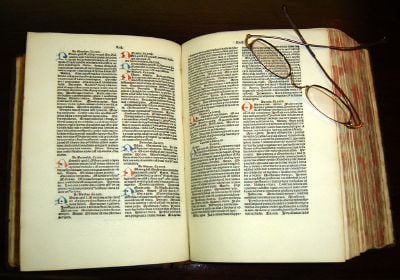
Persia was conquered and incorporated into the Arab Empire, but Persia’s cultural richness filled a cultural vacuum in the pious but rough-and-ready Arab society. Persian literature, philosophy, medicine, and art were about to become a major element of Muslim civilization from Cordoba to Delhi, from Guinea to Samarkand. Persia held a position as a crossroads of the major "highways" of that period.
Persians took key roles in the new Islamic state. Persian Abu Moslem led troops from the Khorasan region to expel the Umayyads from Damascus and helped the Abbasid caliphs conquer Baghdad. Arabs chose their "viziers" (ministers) from among Persians, and Persian governors acquired a certain amount of local autonomy. In the year 822, the governor of Khorasan, Tahir II, proclaimed his independence and founded a new Persian dynasty of Thaheids.
During the ninth and tenth centuries, there was a resurgence of Persian national identity, against Arabization of Islam and Muslims. Epic poet Ferdowsi's Shahnameh (Book of Kings), written in Persian, gave rise to a strong reassertion of Iranian national identity, and is in part responsible for the continued existence of Persian as a separate language. At that time, the Persian language was made the official language.
Scholars made significant advances in mathematics, medicine, astronomy, engineering, and many other fields during this period. Also during this time, Islamic philosophy developed and was often pivotal in scientific debates—key figures were usually scientists and philosophers. Persian scientists Ibn Sina (Avicenna) and Ibn Rushd helped save the works of Aristotle, whose ideas came to dominate the non-religious thought of the Christian and Muslim worlds. Three speculative thinkers, al-Kindi, al-Farabi, and Abū ‘Alī, combined Aristotelianism and Neoplatonism with other ideas introduced through Islam. This Islamic Golden Age influenced the rise of European science, and contributed to the European Renaissance.
Turkish invasion
The Turks gradually infiltrated the Khorasan region along the Caspian coast. In the year 999 C.E., they dominated local Persian dynasties. Mahmud of Ghazni founded a vast empire. He even conquered northern India and helped to propagate in those lands the new Islamic-Persian civilization of which he was the principal protector.
The Saljuqs, his successors, asserted their domination from the Bosphorus to China. These sovereigns usually named Persians as viziers.
Mongol invasion
In 1218, Genghis Khan came down from the Altai Mountains, marched through Iranian territories in Transoxiana to Khorasan, occupied mainland Persia, then turned east through India and China. Holaku, one of the conqueror's grandsons, was left behind to reign over Persia. He soon became "Persianized." Settled in Maragheh (south of Tabriz), he called Persian men of letters to his court and encouraged the sciences and arts.
Yet another conqueror, Tamerlane (Teymur-e Lang), was to be seduced by the mirage of an empire of the Orient. In 1370, he entered Iran, and over a period of 30 years, he conquered Iraq, Syria, Anatolia, Russia, and India. He was about to invade China when he died in 1404. He chose Samarkand as his capital and his kingdom, while administered by Turkmen, it was of distinctively Persian culture.
Safavid Empire
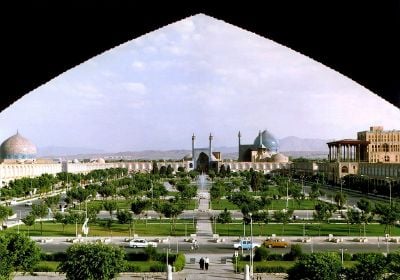
In 1501, the Safavid Empire took control of Iran with Ismail I as its first ruler. To establish political legitimacy, the Safavid rulers claimed to be descended from Imam Ali ibn Abi Talib and his wife Fatima (the daughter of the Prophet Muhammad) through the seventh Imam Musa al-Kazim. To further legitimize his power, Ismail I added claims of royal Sassanian heritage after becoming shah. Persia underwent a revival under the Safavid dynasty (1502–1736). Iran's contemporary Shi’a character and significant segments of Iran's current borders take their origin from this era.
The greatest of the Safavid monarchs, Shah Abbas I the Great (1587–1629) came to power in 1587 at age 16. Abbas I first fought the Uzbeks, recapturing Herat and Mashhad in 1598. Then he turned against the Ottomans, recapturing Baghdad, eastern Iraq, and the Caucasian provinces by 1622. He dislodged the Portuguese from Bahrain in 1602, and the English navy from Hormuz (1622), in the Persian Gulf (a vital link in Portuguese trade with India). He expanded commercial links with the British East India Company and the Dutch East India Company. The Safavid dynasty soon became a major power. Under their rule, Persian architecture flowered again.
Afsharids, Zands and Qajars
A faltering Safavid court eventually gave way to the conqueror Nadir Shah (r. 1736–1747), founder of the Afsharid dynasty. He restored order and implemented policies for preserving the territorial integrity of Iran. In a short period, he conquered Afghanistan and India. The Zand dynasty, founded by Karim Khan, brought a period a peace for Iranians. Later came the Qajar dynasty (1795–1925).
By the seventeenth century, European countries, including Portugal, Great Britain, Imperial Russia, and France, had started establishing colonial footholds in the region. Iran, as a result, lost sovereignty over many of its provinces to these countries via the Turkmanchai Treaty, Gulistan Treaty, and others.
Constitutional revolution
The Iranian Constitutional Revolution was sparked in December 1905, when two Iranian merchants were publicly beaten in Tehran for charging exorbitant prices. Protest against this by other merchants was joined by clerics. An uprising widened when government troops entered a mosque to disperse protesters. In a scuffle in early 1906 the government killed a descendant of the prophet Muhammad, and a large number of clergy sought sanctuary in the holy city Qom.
In the summer of 1906 approximately 12,000 men camped out in the gardens of the British Embassy. It was there that the demand for a parliament was born, the goal of which was to limit the power of the shah. In August 1906, Mozaffareddin Shah agreed to allow a parliament, and in the fall, the first elections were held. The first Majlis (parliament) was convened on October 7, 1906.
The revolution marked the beginning of the end of Iran's feudalistic society and led to the establishment of a parliament. The revolution was the first event of its kind in the Middle East, and opened the way for cataclysmic change in Persia, heralding the modern era.
Oil discovery
The discovery of oil in 1908 by the British in Khuzestan spawned intense renewed interest in Persia by the British Empire and the Anglo-Iranian Oil Company (later BP). Control of Persia remained contested between the United Kingdom and Russia, in what became known as the Great Game, and codified in the Anglo-Russian Convention of 1907, which divided Persia into spheres of influence.
Pahlavi dynasty
In 1921, Reza Khan (later Reza Shah Pahlavi), an officer in Iran's only military force, the Persian Cossack Brigade, used his troops to support a coup against the government of the Qajar dynasty. In 1925, a specially convened assembly deposed Ahmad Shah Qajar, the last ruler of the Qajar dynasty, and named Reza Khan, who earlier had adopted the surname Pahlavi, as the new shah.
Reza Shah had ambitious plans for modernizing Iran. He sent hundreds of Iranians, including his son, to Europe for training. During 16 years from 1925 and 1941, Reza Shah's numerous development projects transformed Iran into an urbanized country. Public education progressed rapidly, and a professional middle class and an industrial working class emerged. By the mid-1930s Reza Shah's dictatorial style of rule caused dissatisfaction among some groups, particularly the clergy who opposed his reforms.
Reza Shah tried to avoid involvement with Britain and the Soviet Union. Even though many of his development projects required foreign technical expertise, he avoided awarding contracts to British and Soviet companies. Although Britain, through its ownership of the Anglo-Iranian Oil Company, controlled Iran's oil resources, Reza Shah got technical help from Germany, France, Italy, and other European countries. This caused a problem for Iran after 1939, when Germany and Britain became enemies in World War II. Reza Shah proclaimed Iran as a neutral country. Britain demanded that Iran expel all German citizens, but Reza Shah refused.
Second World War
Following Germany's invasion of the Soviet Union in June 1941, Britain and the Soviet Union, who became allies, saw the newly opened Trans-Iranian Railroad as a route to transport supplies from the Persian Gulf to the Soviet region. In August 1941, because Reza Shah refused to expel Germans, Britain and the Soviet Union invaded Iran, arrested him, and sent him into exile, taking control of Iran's communications and railroad.
In 1942, the United States, an ally of Britain and the Soviet Union, sent a military force to help maintain and operate sections of the railroad. The British and Soviet authorities allowed Reza Shah's system of government to collapse, and permitted Reza Shah's son, Mohammad Reza Pahlavi, to succeed to the throne.
In January 1942, British and Soviet authorities agreed to respect Iran's independence and to withdraw their troops within six months of the war's end. In 1945, the Soviet Union delayed leaving Iran's northwestern provinces of East Azerbaijan and West Azerbaijan, where Soviet-supported autonomy movements had developed. The Soviet Union withdrew its troops in May 1946, but tensions continued. This episode helped precipitate the Cold War, the post-war rivalry between the United States and the Soviet Union and their allies.
The Cold War
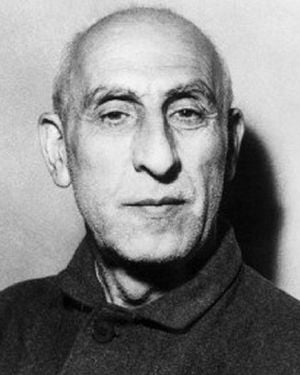
In 1951, a pro-democratic nationalist, Dr. Mohammed Mossadegh, was elected prime minister. Mossadegh alarmed the West by nationalizing the Anglo-Iranian Oil Company (later British Petroleum, BP) that had controlled the country's oil reserves. Britain immediately embargoed Iran.
Members of the British Intelligence Service invited the United States to join them in covertly overthrowing Mossadegh. United States President Harry S. Truman refused, but Dwight D. Eisenhower agreed, and authorized the CIA to take the lead in overthrowing Mossadegh and supporting a U.S.-friendly monarch. Agents were hired to facilitate violence; and, as a result, protests broke out across the nation. Anti- and pro-monarchy protestors clashed, leaving 300 dead. The operation triggered a coup, and within days, pro-Shah tanks stormed the capital and bombarded the prime minister's residence. Mossadegh surrendered, and was arrested on August 19, 1953. He was tried for treason, and jailed for three years.
With strong support from the United States and the United Kingdom, Shah Mohammad Reza Pahlavi further modernized Iranian industry, but crushed all political opposition with his intelligence agency, SAVAK. Ayatollah Ruhollah Khomeini denounced the Shah's White Revolution. Khomeini, who was popular in religious circles, was jailed for 18 months. After his release in 1964, Khomeini criticized the United States government. Khomeini was exiled, first to Turkey and then to Iraq.
Islamic Revolution
Protests against the shah increased in 1979, culminating in the Iranian Revolution. The Shah fled, and Khomeini returned from exile on February 1, 1979. On February 11, Khomeini declared a provisional government led by Prime Minister Mehdi Bazargan, and on March 30 to March 31, asked all Iranians to vote in a referendum on establishing an Islamic republic. Over 98 percent of Iranians supported an Islamic republic.
Iranian students seized U.S. embassy personnel on November 4, 1979, labeling the embassy a "den of spies" and accused its personnel of being CIA agents trying to overthrow the revolutionary government, as the CIA had done to Mohammad Mossadegh in 1953.
Khomeini supported the embassy takeover, a move that only increased his popularity among the revolutionaries. Despite U.S. President Jimmy Carter's attempts at negotiating and rescuing the hostages, in what became known as the Iran hostage crisis, Iran refused to release them and threatened to put them on trial for espionage. The students demanded the handover of the shah in exchange for the hostages. This exchange never took place. After 444 days of captivity, embassy employees were allowed to return to the United States.
Iran-Iraq War

Meanwhile, Iraqi leader Saddam Hussein decided to take advantage of perceived disorder in the wake of the Iranian Revolution. The once-strong Iranian military had been disbanded, and with the shah ousted, Saddam wanted to position himself as the new strongman of the Middle East. He also sought to expand Iraq's access to the Persian Gulf by acquiring Khuzestan, which had a substantial Arab population and rich oil fields, and the islands of Abu Musa and the Greater and Lesser Tunbs.
On September 22, 1980, the Iraqi army invaded Iran at Khuzestan, taking revolutionary Iran by surprise. Although Iraqi forces made early advances, by 1982, Iranian forces pushed the Iraqi army back into Iraq. Khomeini refused a cease-fire from Iraq, demanding huge reparation payments, an end to Saddam's rule, and that Saddam be tried for crimes against humanity. Khomeini also sought to export his Islamic revolution into Iraq, especially on the majority Shi'a Arabs there. The war continued until 1988, when Khomeini accepted a truce mediated by the United Nations.
Iraq was financially backed by Egypt, the Arab countries of the Persian Gulf, the Soviet Union and the Warsaw Pact states, the United States (beginning in 1983), France, the United Kingdom, Germany, Brazil, and the People's Republic of China (which also sold weapons to Iran). Iran's principal allies were Syria, Libya, and North Korea.
Tens of thousands of Iranian civilians and military personnel were killed when Iraq used chemical weapons. The total Iranian casualties of the war were estimated to be anywhere between 500,000 and 1,000,000.
Invasions
The Soviet invasion of Afghanistan brought some three million Afghan refugees to Iran. In 1989, Khomeini died and was succeeded by Ayatollah Ali Khamenei. The presidency was soon filled by Ali Akbar Rafsanjani, who sought improved relations with Western nations, diminishing the influence of revolutionary factions, and embarked on a military build-up. An earthquake hit northern Iran on June 21, 1990, killing nearly 40,000 people.
When Iraq invaded Kuwait in August 1990, Iran adhered to international sanctions against Iraq. However, Iran condemned the use of U.S.-led coalition forces against Iraq during the Persian Gulf War (1991). As a result of the war and its aftermath, more than one million Kurds crossed the Iraqi border into Iran as refugees.
Rafsanjani was reelected president in 1993. The United States suspended all trade with Iran in 1995, accusing Iran of supporting terrorist groups and attempting to develop nuclear weapons. In 1997, Mohammad Khatami, a moderately liberal Muslim cleric, was elected president. Several European Union countries began renewing economic ties with Iran in the late 1990s. In 1999, as new curbs were put on a free press, pro-democracy student demonstrations erupted, followed by counter demonstrations by conservatives.
Reformers won about two thirds of the seats in the February 2000 parliamentary elections, but conservative elements in the government closed the reformist press, and attempts to repeal restrictive press laws were forbidden by Khamenei. Despite these conditions, President Khatami was overwhelming reelected in June, 2001.
On January 29, 2002, U.S. President George W. Bush labeled Iran, along with Iraq and North Korea as an "Axis of evil." The speech sparked demonstrations across Iran. Tensions with the United States increased after the American invasion of Iraq in March 2003, as U.S. officials continued to denounce Iran for allegedly developing nuclear weapons. In October 2003, however, Iran agreed to tougher international inspections of its nuclear installations.
An earthquake, centered on Bam in southeast Iran, killed more than 26,000 people in December 2003.
Nuclear disputes
In mid-2004, Iran began resuming the processing of nuclear fuel, saying that negotiations with European Union nations had failed to bring the promised access to the advanced nuclear technology. The United States said that the processing of nuclear fuel would give Iran the capability to develop nuclear weapons. The International Atomic Energy Agency (IAEA) said that there was no evidence that Iran was seeking to develop such arms, but also called for Iran to abandon its plans to produce enriched uranium. In November 2004, Iran agreed to suspend uranium enrichment, but said that it would not be held to the suspension if the negotiations with EU nations failed.
The presidential election in June 2005 was won by the hard-line conservative mayor of Tehran, Mahmoud Ahmadinejad, who ran on a populist, anti-corruption platform. Ahmadinejad's victory gave conservatives control of all branches of Iran's government.
After Iran resumed converting raw uranium into gas in August 2005, a necessary step for enrichment, the IAEA passed a resolution that accused Iran of failing to comply with the Nuclear Non-proliferation Treaty and called for the agency to report Iran to the UN Security Council.
In October 2005, Ahmadinejad held a conference titled "The World without Zionism," where he said he hoped the Zionist regime occupying Jerusalem, would collapse. The Western media falsely interpreted Ahmadinejad’s speech as calling for genocide and a controversial translation of Ahmadinejad’s speech was that Ahmadinejad was calling for "Israel to be wiped off the map." Further dialogue surrounding this speech concludes that Admadinejad and Iran were calling not for the genocide of Israel, but for the formation of one state with Israeli and Palestinian agreement and cooperation.
In February, 2006, the IAEA voted to report Iran to the United Nations Security Council. In response, Iran resumed uranium enrichment and ended surprise IAEA inspections and surveillance of its nuclear facilities. The Security Council called for Iran to suspend its nuclear research program in 30 days, but the statement left unclear what, if any, response there would be if Iran refused. On April 11, 2006, Iranian President Mahmoud Ahmadinejad announced that Iran had successfully enriched uranium.
The enrichment program caused the nations involved, China, France, Germany, Russia, the United States, and the nations of the EU, to refer the issue back to the Security Council in July 2006. The council set an August 31 deadline for Iran to stop enrichment, but Iran insisted it would continue its program and ignored the deadline.
On May 8, 2006, Ahmadinejad sent a personal letter to U.S. President George W. Bush to propose "new ways" to end Iran's nuclear dispute. It was the first direct contact between the American and Iranian heads of state since April 9, 1980.
On December 23, 2006, the United Nations Security Council unanimously passed Resolution 1737, which imposed sanctions against Iran for failing to stop its uranium enrichment program following Resolution 1696.
Government and politics
The political system of the Islamic Republic of Iran is based on the 1979 constitution called the Qanun-e Asasi (Fundamental Law). The system comprises several intricately connected governing bodies.
Governing bodies
The Supreme Leader of Iran is responsible for general policies, is commander-in-chief of the armed forces, controls military intelligence, and has sole power to declare war. He appoints judiciary heads, state radio and television heads, police and military commanders, and six of the 12 members of the Council of Guardians. The Assembly of Experts elects and dismisses the supreme leader on the basis of qualifications and popular esteem, and is responsible for supervising the supreme leader.
The President is the highest state authority, and is elected by universal suffrage for a term of four years. The Council of Guardians approves presidential candidates. The president implements the constitution and exercises executive powers, except for matters directly related to the supreme leader. The president appoints and supervises the Council of Ministers, coordinates government decisions, and selects government policies to be placed before the legislature. Eight vice-presidents serve under the president, as well as a cabinet of 21 ministers, who must all be approved by the legislature. The executive branch does not control the armed forces. Although the president appoints the ministers of intelligence and defense, the president must obtain approval from the supreme leader before presenting them to the legislature.
The Council of Guardians comprises 12 jurists including six appointed by the supreme leader; the remaining six are appointed by parliament (Majles). If a law is deemed incompatible with the constitution or Sharia (Islamic law), it is referred back to parliament for revision.
The Expediency Council has the authority to mediate disputes between parliament and the Council of Guardians, and serves as an advisory body to the supreme leader, making it one of the most powerful governing bodies in the country.
The Majlis of Iran (Islamic Consultative Assembly), or parliament, is comprised of 290 members elected for four-year terms. The Majlis drafts legislation, ratifies international treaties, and approves the national budget. All Majlis candidates and all legislation from the assembly must be approved by the Council of Guardians.
The supreme leader appoints the head of the judiciary, who in turn appoints the head of the Supreme Court and the chief public prosecutor. Public courts deal with civil and criminal cases, and "revolutionary courts" deal with crimes against national security. The decisions of the revolutionary courts cannot be appealed. The Special Clerical Court handles crimes committed by clerics, functions independently of the regular judicial framework, and is accountable only to the supreme leader. The court's rulings are final and cannot be appealed.
The Assembly of Experts, which meets for one week annually, comprises 86 "virtuous and learned" clerics elected by adult suffrage for eight-year terms. The Council of Guardians determines candidates' eligibility. The assembly elects the supreme leader and has the constitutional authority to remove the supreme leader from power at any time. The assembly has never been known to challenge any of the supreme leader's decisions.
City and village councils are elected by public vote to four-year terms. Councils elect mayors, supervise municipalities, and implement social, economic, constructive, cultural, educational, and other welfare affairs.
Politics
Formal political parties are relatively new in Iran, and most conservatives still prefer to work through political pressure groups rather than parties. Often political parties or groups are formed prior to elections and disbanded soon thereafter.
A loose pro-reform coalition called the Second Khordad Front, which includes political parties as well as less formal pressure groups and organizations, achieved considerable success at elections to the sixth Majles in early 2000. The coalition includes: Islamic Iran Participation Front (IIPF), Executives of Construction Party (Kargozaran), Solidarity Party, Islamic Labor Party, Mardom Salari, Mojahedin of the Islamic Revolution Organization (MIRO), and Militant Clerics Society (Ruhaniyun). The coalition participated in the seventh Majles elections in early 2004.
The Islamic Revolutionary Party (IRP) was Iran's sole political party until its dissolution in 1987. Groups that support the Islamic republic include Ansar-e Hizballah, Muslim Students Following the Line of the Imam, Tehran Militant Clergy Association (Ruhaniyat), Islamic Coalition Party (Motalefeh), and Islamic Engineers Society. Active pro-reform student groups include the Office of Strengthening Unity (OSU). Opposition groups include Freedom Movement of Iran, the National Front, and Marz-e Por Gohar.
Various armed political groups that have been repressed include Mujahidin-e Khalq Organization (MEK or MKO), People's Fedayeen, Democratic Party of Iranian Kurdistan (KDPI), and Komala.
Iran is divided into 30 provinces (ostanha).
Military
Iran has two kinds of armed forces: the regular forces and the Islamic Revolutionary Guards Corps, totaling about 545,000 personnel. Both fall under the command of the ministry of defense. The regular armed forces have an estimated 420,000 troops in three branches: ground forces (350,000 troops), navy (18,000 sailors), and air force (52,000 airmen). The Islamic Revolutionary Guards Corps has an estimated 125,000 personnel in five branches: Qods force (special forces), Basij (paramilitary), navy, air force, and the ground forces.
Iran also has a paramilitary volunteer force called the Basij, which includes about 90,000 full-time, active-duty uniformed Basij members, up to 300,000 reservists, and a further 11 million men and women who could be mobilized.
Iran's military capabilities are kept largely secret. In the early 2000s, official announcements have highlighted the development of weapons such as Fajr-3 (MIRV) missile, Hoot, Kowsar, Fateh-110, Shahab-3, and a variety of unmanned aerial vehicles.
Iran is a founding member of the United Nations, the Non-Aligned Movement (NAM), the Organization of the Islamic Conference (OIC), the Organization of the Petroleum Exporting Countries (OPEC), and the Economic Cooperation Organization (ECO).
Economy
Iran's economy is marked by a bloated, inefficient state sector, over-reliance on the oil sector, and statist policies that create distortions throughout the nation. Most economic activity is controlled by the state. Private sector activity is typically small-scale workshops, farming, and services.
Relatively high oil prices in recent years have enabled Iran to amass nearly $60-billion in foreign exchange reserves, but have not eased high unemployment and inflation. The proportion of the economy devoted to the development of weaponry remains a contentious issue with leading Western nations.
In the early twenty-first century, the service sector contributed the largest percentage of the GDP, followed by industry (mining and manufacturing) and agriculture. About 45 percent of the government's budget came from oil and natural gas revenues, and 31 percent came from taxes and fees.
In 2004, the GDP was estimated at $542 billion of purchasing power parity, or $8,100 per capita, 71st on a list of 181 nations. Because of these figures and the country’s diversified but small industrial base, the United Nations classified Iran's economy as semi-developed.
Over 20 percent of Iran's GDP is controlled by bonyads, which are Iranian charitable trusts. Initially set up during the time of the shah of Iran, they were used to funnel money into the shah's personal coffers. After the Iranian Revolution, the bonyads were used to redistribute oil income among the poor and the families of martyrs.
Iran is OPEC's second-largest oil producer, exporting over three million barrels of oil per day. Moreover, it holds 10 percent of the world's confirmed oil reserves. Iran also has the world's second-largest natural gas reserves (after Russia).
The administration continues to follow market reform plans and diversify Iran's oil-reliant economy. It is attempting to do this by investing revenues in areas like automobiles, manufacturing, aerospace industries, consumer electronics, petrochemicals, and nuclear technology. Iran has developed biotechnology, nanotechnology, and pharmaceuticals industries.
Iranian budget deficits have been a chronic problem, in part due to large-scale state subsidies (totaling some $30 billion per year) that include foodstuffs and especially gasoline.
Since the late 1990s, Iran has increased its economic cooperation with other developing countries, including Syria, India, Cuba, Venezuela, and South Africa. Iran is also expanding its trade ties with Turkey and Pakistan and shares with its partners the common goal of creating a single economic market in West and Central Asia, much like the European Union.
Export commodities include petroleum, chemical and petrochemical products, fruits and nuts, and carpets. Export partners include Japan, China, Italy, South Korea, Turkey, Netherlands, France, South Africa, and Taiwan.
Import commodities include industrial raw materials and intermediate goods, capital goods, foodstuffs and other consumer goods, technical services, and military supplies. Import partners include Germany, United Arab Emirates, China, Italy, France, South Korea, and Russia.
Demographics
Iran's population increased dramatically during the latter half of the twentieth century. More than two-thirds of the population is under the age of 30, and nearly one-quarter of its people are 15 years of age or younger. The Iranian diaspora is estimated at over four million people who emigrated to North America, Europe, South America, and Australia, mostly after the Iranian Revolution in 1979. Iran also hosts one of the largest refugee populations in the world, with more than one million refugees, mostly from Afghanistan and Iraq.
Ethnicity
The majority of Iranians are Persian, with other ethnic groups including Azeris, Gilaki and Mazandarani, Kurds, Arabs, Baluchi, Lurs, Turkmens, Qashqai, Armenians, Persian Jews, Georgians, Assyrians, Circassians, Tats, Pashtuns, and others making up the rest of the population. There is little ethnic conflict, although the Kurds, living on Iran's western border, have pushed for autonomy. Nomadic tribal groups in the southern and western regions have been difficult to control. The Arab population of the southwestern province of Khuzestan has aspired to break away from Iran.
Religion
Ninety percent of Iranian people belong to the Shi'a branch of Islam, the official state religion, and about 8 percent, mainly Kurds, belong to the Sunni branch. The remaining 2 percent are non-Muslim religious minorities, mainly Bahá'ís, Mandeans, Hindus, Zoroastrians, Jews, and Christians. The latter three minority religions are officially recognized, and have reserved seats in the Majles' (Parliament). However the Bahá'í Faith, Iran's largest religious minority, is not officially recognized, and since the 1979 revolution, persecution has increased with executions and access to higher education denied.
The state religion of “Ithnaashara,” or Twelver Shi'ism, was established by the Safavid Dynasty in the seventeenth century. Shi'a Muslims revere the descendants of Fatimah, daughter of the prophet Muhammad, and her husband, Ali, Muhammad's cousin. Twelve Imams are recognized, all of whom were martyred except the twelfth, Muhammad al-Mahdi, who disappeared, but it is believed that he will return at the end of time with Jesus to judge mankind. Husayn ibn Ali, one of two sons of Fatimah and Ali, the central figure in Iranian Shi’ism, was martyred in a struggle for power between rival sects, which became Shi'a and Sunni. The Islamic months of Muharram and Safar are time for ritual mourning for Husayn, with processions, self-flagellation, and 10-day dramatic depictions of the martyrdom. Also revered is Imam Reza, the eighth leader of Shi'a Muslims, who is buried in the northeastern Iranian city, Mashhad. His shrine is a key pilgrimage destination for Shi'a Muslims.
Among religious minorities in Iran, Zoroastrians date back more than two thousand years, Iranian Jews date back to the removal to Babylon, and Assyrian Christians, who follow a non-Trinitarian doctrine, have lived continually in Iran since the third century C.E.
Arab and Baluchi populations in the south and Turkish populations in the north and west are Sunni Muslims. The Baha'i movement, a semi-mystical nineteenth-century departure from Shi'ia Islam, is homegrown. It won converts from Islam, Judaism, Zoroastrianism, and Christianity, and has spread from Iran to every nation on earth. Sufis focus on a meditative path that may include group chanting and dance.
A young man wanting to be a cleric may train in a religious school. When he has completed a course of study, he takes up residence in a community needing a cleric. Overtime, he may build a reputation as a “mujtahed” capable of interpreting Islamic law, and as he gains respect and followers, he may rise to become an ayatollah (literally, “Reflection of God”).
Shrines of Islamic saints are important. A pilgrimage to a shrine is a common. Longer pilgrimages to Karbala, Mashhad, or Mecca are respected. There are 30 holidays in Iran revolving around the birth or death of the various Shi'a imams.
Roles of men and women
Women have always had a strong role in Iranian life. Women have served in government since the 1950s. The marriage age for women has increased to 21 years, while the birthrate has fallen to 2.45 percent. Education for women is universal, and education for girls has increased steadily. All professions are theoretically open to women, but the Iranian government’s requirement to cover the hair and the female form limits the type of jobs available. Revolutionary guards have mutilated women for showing too much hair or for wearing lipstick.
In Iran, it is considered manly for men to be emotionally sensitive, artistically engaged, and aesthetically acute, while women can be emotionally distant and detached. Open weeping is common for either sex, as is kissing and hand holding between members of the same sex. Physical contact between members of the opposite sex, such as shaking hands, is avoided except between relatives. A proper Iranian man or woman will not be in a closed room with a member of the opposite sex (except for his or her spouse).
Marriage and the family
Marriage in Iran merges two families, giving each family extensive rights and obligations. Therefore, the families want to be certain they are compatible before any marriage takes place. A mother is on the lookout for good marriage prospects for her children. Once a prospect is selected, the mother lets her counterpart in the other family know that a proposal would be made, or would be welcome. The husband makes the proposal.
A man of marriageable age has a right of first refusal for his father's brother's daughter—his cousin. This type of marriage consolidates wealth from the grandparents' generation. A love match with someone outside the family is not impossible, but the family visitation and negotiation must be observed.
A cleric draws up a marriage contract. The bride brings a dowry consisting of household goods and her clothing. An amount is written into the contract as payment for the woman should divorce occur. The wife belongs to her husband's household, but retains her name, and may hold property separate from her husband. A celebration is held after the contract is signed, and is a prelude to the consummation of the marriage. In many areas, it is important that the bride is virginal, and the bed sheets are inspected. The new couple may live with their relatives until they set up their own household.
Polygyny is allowed, but not widely practiced. Divorce is less common than in the West. Families prefer to stay together, since it is difficult to untangle the close relationships between the two families. Children of a marriage belong to the father. After a divorce, men assume custody of boys over three years and girls over seven. Women sometimes renounce their divorce payment to get custody.
Branches of an extended family may live in rooms in the same compound, but have separate eating and sleeping arrangements. Members of extended families have wide rights to hospitality in the homes of even their most distant relations. Family members tend to socialize with each other.
Male children inherit full shares of their father's estate, wives and daughters half-shares. The patriarch is the oldest male of the family, and he demands respect from other family members. The extended family aims to extend its influence into as many spheres as possible. Some family members will go into government, others into the military, others join the clergy. Families try to marry their children into powerful families.
Small children are indulged. Older children often raise younger children, especially in rural settings. The father is the disciplinarian of the family, and is responsible to protect family honor. If a girl remains chaste, virginal, modest, and has beauty and education, she can marry well. If she fails in this, she may ruin her own life, and the reputation of her family. Boys are more indulged than girls, and are taught to protect family honor.
Land ownership
Absentee landlords for hundreds of years used a sharecropping arrangement with tenant farmers. Based on a principle of five shares—land, water, seed, animal labor, and human labor—the farmer received at most two-fifths of the produce, since he supplied only the human and animal labor. Landlords hired laborers to work for wages. Land reforms in the 1960s and 1970s resulted in sharecropping farmers receiving land, while the wage farmers received nothing.
Nomadic tribes claim grazing rights along their route of migration, with the rights parceled out by family affiliation. Government officials contest this.
Landowners on their death have willed large tracts of land, including whole villages, as well as other property, to the religious bequest (waqf) trust. The Pahlavi rulers sought to break the economic power of the clergy, who controlled this vast property empire, by nationalizing it, an action vehemently opposed by the clergy before the revolution.
Language
"Persian" is the name for the primary language spoken by around 40 million in Iran. However, the Iranian languages and their various dialects (totaling an estimated 150-200 million speakers) exceed the Iranian borders and are spoken throughout western China, southern Russia, and eastern Turkey. As part of the Indo-Iranian branch of the Indo-European languages, it is an ancient language, and one of extraordinary grace and flexibility. Having absorbed Arabic vocabulary and many Turkish elements, its vocabulary has expanded to well over 100,000 commonly used words. It is easy to learn, and ideally suited for poetry and literature. The language is remarkably stable; Iranians can read twelfth-century literature with relative ease. Iranian residents whose first language is not Persian are bilingual in Persian and their primary language. Persons whose first language is Persian are usually monolingual.
Class
In Iran, a man in ragged clothes, unshaven, and without any outward trapping of luxury may in fact be rich and powerful, and a well-dressed man driving a fine European car may be mired in debt. Clever youths from poor backgrounds may become educated, and, with the help of persons of power and authority, they rise quickly in status and wealth. The public tends to dismiss awards, promotions, and public accolades. Clerics advance through the informal acknowledgment of their peers. “Ta'arof,” a ritualized system of speech and behavior, allows individuals to interrelate in a harmonious fashion, recognizing each other’s status.
Culture
Iran has a long history of art, music, architecture, poetry, philosophy, traditions, and ideology. Iranian culture has long been a predominant culture of the Middle East and Central Asia, with Persian considered the language of intellectuals during much of the second millennium C.E. Nearly all philosophical, scientific, or literary work of the Islamic empires was written in Persian and translated to Arabic.
Cuisine
The cuisine of Iran is diverse, with each province featuring dishes, as well as culinary traditions and styles, distinct to their regions. It includes a wide variety of foods ranging from chelow kabab barg, koobideh, joojeh, shishleek, soltani, chenjeh, khoresht (stew that is served with white basmati or Persian rice: ghormeh sabzi, gheimeh, and others), aash (a thick soup), kookoo (meat and/or vegetable pies), polow (white rice alone or with addition of meat and/or vegetables and herbs, including loobia polow, albaloo polow, zereshk polow, and others), and a diverse variety of salads, pastries, and drinks specific to different parts of Iran. The list of Persian recipes, appetizers, and desserts is extensive.
Iranian food is not spicy. Herbs are used a lot, as is fruit from plums and pomegranates to quince, prunes, apricots, and raisins. The main Persian cuisines are combinations of rice with meat, chicken, or fish, and plenty of garlic, onion, vegetables, nuts, and herbs. To achieve a balanced taste, unique Persian spices such as saffron, diced limes, cinnamon, and parsley are mixed delicately and used in some special dishes.
The traditional Iranian table setting firstly involves the tablecloth, called sofreh, which is often embroidered with traditional prayers and/or poetry, and is spread out over a Persian rug or table. Main dishes are concentrated in the center, surrounded by smaller dishes containing appetizers, condiments, side dishes, as well as bread, all of which are nearest to the diners.
Essential accompaniments include a plate of fresh herbs, called sabzi (basil, coriander, cilantro, tarragon, Persian watercress or shaahi), a variety of flat breads, called nan or noon (sangak, lavash, barbari), cheese (called panir, a Persian variant of feta), sliced and peeled cucumbers, sliced tomatoes and onions, yogurt, and lemon juice. Persian pickles (khiyarshur) and relishes (torshi) are also considered essential.
Tea (chai) is served at breakfast and immediately before and after each meal at lunch and dinner, and many times throughout the rest of the day.
Popular fast foods include chelow kebab (literally "rice and kebab"), and nan-e kebab kebab sandwiches. A preference for American food has resulted in many pizza, steak, hamburger, and fried chicken establishments. Chinese and Japanese cuisine has become popular.
The traditional drink accompanying meals is called doogh. However many domestic sodas such as Zam Zam Cola and Parsi Col are widely consumed. Both Coca Cola and Pepsi Cola have bottling plants in Mashad. There are several types of sherbets and khak sheer. One favorite is havij bastani, carrot juice made into an ice cream float and garnished with cinnamon, nutmeg, or other spices.
Though strictly banned, alcoholic beverages may be available, but not openly available. The most common beverage is called Arak (liqueur). Vodka is the second most commonly available alcohol, imported from Russia. Beer is imported from northern Europe via Turkey. Wine has been a big part of Iranian culture since ancient times, and this tradition has continued despite restrictions. Wine-producing centers are Qazvin, Orumiyeh, Shiraz, and Isfahan. Red wine is the most common variety.
Clothing
Women wear non-transparent, loose garments covering all their bodies except for the hands and face. Color is optional but red, orange, pink, or similar colors are not put on during national or private sad occasions. Black is not required. Women wear the chador, a semicircular piece of dark cloth that is wrapped around the body and head, and gathered at the chin. Westernized Iranian women regard this dress requirement as oppressive. Wearing a chador is not mandatory. Men wear non-transparent garments too. They may wear short-sleeve shirts or T-shirts (unlike women), but not shorts, in public. The choice of color is the same for men as well.
Architecture
The main building types of classical Iranian architecture are the mosque and the palace. The architecture makes use of abundant symbolic geometry, using pure forms such as the circle and square. Plans are based on symmetrical layouts featuring rectangular courtyards and halls.
The post-Islamic architecture of Iran has geometrical and repetitive forms, as well as surfaces that are richly decorated with glazed tiles, carved stucco, patterned brickwork, floral motifs, and calligraphy.
Persians were among the first to use mathematics, geometry, and astronomy in architecture. Teppe Sialk, an important ziggurat near Kashan, built 7,000 years ago, represents one such prehistoric site in Persia whose inhabitants were the initiators of a simple and rudimentary housing technique.
Each of the periods of Elamites, Achaemenids, Parthians, and Sassanids were represented by great architecture. Although Iran has suffered its share of destruction, including Alexander the Great's decision to burn Persepolis, there are sufficient remains to form a picture of its classical architecture.
In the Old Persian architecture, semi-circular and oval-shaped vaults were of great interest, leading Safavid architects to display their extraordinary skills in making massive domes. Domes can be seen frequently in the structure of bazaars and mosques, particularly during the Safavid period in Isfahan. Iranian domes are distinguished for their height, proportion of elements, beauty of form, and roundness of the dome stem. The outer surfaces of the domes are mostly mosaic faced, and create a magical view.
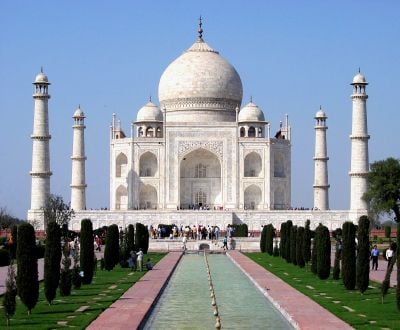
Persian architects were a highly sought after. For example, Ostad Isa Shirazi is most often credited as the chief architect of the Taj Mahal in India. These artisans were highly instrumental in the designs of such edifices as Afghanistan's Minaret of Jam, the Sultaniyeh Dome, or Tamerlane's tomb in Samarkand, among many others.
Education
Families emphasize education for both boys and girls. Iranian education relies much on rote memorization, following the French system. Children are encouraged in the arts, and are taught to write poetry and learn music, painting, and calligraphy.
Kindergarten, which is not mandatory, begins at the age of five and lasts for one year. Grade school (dabestan) starts at the age of six and lasts for five years. Junior high school goes from sixth to eighth grade. This aims at evaluating the student’s proficiency to pursue higher education or vocational/technical education during senior high school (dabirestan), which lasts three years, and which is neither mandatory nor free. It is divided between theoretical, vocational/technical, and manual programs, each program with its own specialties.
Universities, institutes of technology, medical schools, and community colleges provide higher education. The requirement to enter into higher education is to have a high school diploma, followed by a one-year preparation class, and finally pass the national university entrance exam. Higher education is sanctioned by different levels of diplomas: Fogh-Diplom or Kardani (equivalent to a baccalaureate in technical engineering) is awarded after two years of higher education, Karshenasi (also known as a “license”), is given after four years of higher education (bachelor’s degree). Fogh License is awarded after two more years of study (master’s degree). After which, a new entrance exam allows the candidate to pursue a doctoral program (PhD).
Scientific progress
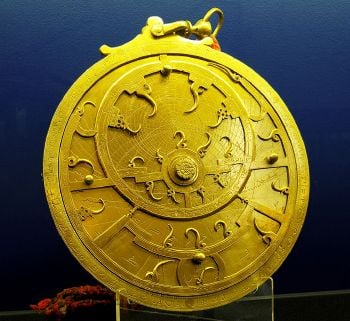
Persians discovered algebra, invented the windmill, and found medicinal uses for alcohol. Today, theoretical and computational sciences are rapidly developing. Theoretical physicists and chemists are regularly publishing. Despite the limitations in funds, facilities, and international collaborations, Iranian scientists remain highly productive in pharmacology, pharmaceutical chemistry, organic chemistry, and polymer chemistry.
Iranian molecular biophysicists have gained an international reputation since the 1990s. High field nuclear magnetic resonance facilities, as well as microcalorimetry, circular dichroism, and instruments for single protein channel studies have been provided. Tissue engineering and research on biomaterials has emerged. In late 2006, Iranian scientists cloned a sheep by somatic cell nuclear transfer.
Fine arts
The Persian carpet is similar to the Persian garden: full of flowers, birds, and beasts. The colors are usually made from wild flowers, and are rich in burgundy, navy blue, and accents of ivory. The proto-fabric is often washed in tea to soften the texture. Depending on where the rug is made, patterns and designs vary.
Caves in Iran's Lorestan province exhibit painted imagery of animals and hunting scenes. Some, such as those in Fars Province and Sialk, are at least 5,000 years old. Painting in Iran is thought to have reached a climax during the Tamerlane era when outstanding masters such as Kamaleddin Behzad created a new style of painting.
Paintings of the Qajar period, are a combination of European influences and Safavid miniature schools of painting. It was during that era when "Coffee House painting" emerged. Subjects of this style were often religious in nature depicting scenes from Shi’a epics.
Of the thousands of archaeological sites and historic ruins of Iran, almost every one can be found to have been filled, at some point, with earthenware of exceptional quality. Thousands of unique vessels alone were found in the Sialk and Jiroft sites.
Music
The earliest references to musicians in Iran are found in Susa and Elam in the third millennium B.C.E. Reliefs, sculptures, and mosaics such as those in Bishapur, from periods of antiquity, depict a vibrant musical culture. Persian traditional music in its contemporary form has its inception in the Naseri era, who ordered the opening of a "House of Crafts," where all master craftsmen would gather for designing instruments and practicing their art.
Literature
Iran's literary tradition is rich and varied as well, although the world is most familiar with Iranian poetry. Rumi is by far the most famous of Iran's poets, although Saadi is considered by many Iranians to be just as influential. Both poets were practitioners of Sufism, and are quoted by Iranians with the same frequency and weight as the Qur'an.
Poetry
So strong is the Persian aptitude for versifying everyday expressions that one can encounter poetry in almost every classical work, whether from Persian literature, science, or metaphysics. In short, the ability to write in verse form was a prerequisite for any scholar. For example, almost half of Avicenna's medical writings are known to be versified. Persian poetry is recognized worldwide and has served as an inspiration for writers and poets around the world. Works of the early era of Persian poetry are characterized by strong court patronage, an extravagance of panegyrics, and what is known as سبک فاخر, "exalted in style."
Cinema
The cinema of Iran is a flourishing film industry with a long history. Many popular commercial films are made in Iran, and Iranian art films have won many international film awards. Festivals of Iranian films are held annually around the globe. Along with China, Iran has been lauded as one of the best exporters of cinema in the 1990s.
Many critics now rank Iran as the world's most important national cinema artistically, with a significance that invites comparison to Italian neo-realism and similar movements in the past.
The state also actively monitors the internet, which has become enormously popular among Iranian youth. Iran is now the world's fourth-largest country of "bloggers."
Sports
Tehran was the first city in the Middle East to host the Asian Games in 1974, and continues to host and participate in international sporting events.
Football (soccer) is by far the most popular sport in Iran. Iran has reached the World Cup finals three times, and its national team is among the football elite in Asia. Many Iranians play in European leagues and many Iranian clubs have hired European players or coaches.
The Tochal resort is the world's fifth-highest ski resort at over 3,730 meters at its highest seventh station. It is only 15 minutes away from Tehran's northern districts. From the Tochal peak, one has a spectacular view of the Alborz range, including the 18,606-foot (5671 meter) high Mount Damavand, a dormant volcano.
Martial arts have exploded in popularity in recent years. Kyokushin, Shotokan, Wushu, and Taekwondo are the most popular. There are also indigenous styles such as Shinzen Karate.
Other popular sports are volleyball, rallying, and basketball. In basketball, Iran has a national team, and a professional league, with good players in Asia. The clubs have begun hiring foreign players and coaches into their roster.
In rallying, women drivers participate in national rally tournaments. Also, traditional sports like chess, backgammon, polo, and wrestling are popular.
Notes
- ↑ Andrew J. Newman, Safavid Iran: Rebirth of a Persian Empire (I.B. Tauris, 2008, ISBN 978-1845118303).
- ↑ Iran Population Worldometer. Retrieved June 22, 2021.
- ↑ 3.0 3.1 3.2 3.3 World Economic Outlook Database, October 2020 International Monetary Fund. Retrieved June 22, 2021.
- ↑ Gini index (World Bank estimate) GINI index (World Bank estimate) The World Bank. Retrieved June 22, 2021.
ReferencesISBN links support NWE through referral fees
- Batmanglij, Najmieh. The New Food of Life: A Book of Ancient Persian and Modern Iranian Cooking and Ceremonies. Washington, DC: Mage Publishers, 1992. ISBN 0934211345
- Fisher, W.B. (ed.). The Cambridge History of Iran Vol. 1: The Land of Jordan. Cambridge University Press, 1968. ISBN 0521069351
- Frye, N.R. (ed.). The Cambridge History of Iran Vol. 4: 'From the Arab Invasion to the Saljuqs. Cambridge University Press, 1975. ISBN 0521200938
- Hole, Frank (ed.). The Archaeology of Western Iran: Settlement and Society from Prehistory to the Islamic Conquest. Smithsonian Institution Press, 1987. ISBN 0874745268
- Langton, Christopher (ed.). The Military Balance 2006. London: Routledge, 2006. ISBN 1857433998
- Najmabadi, Afsaneh. Land Reform and Social Change in Iran. University of Utah Press, 1987. ISBN 0874802857
- Newman, Andrew J. Safavid Iran: Rebirth of a Persian Empire. I.B. Tauris, 2008. ISBN 978-1845118303
External links
All links retrieved June 22, 2021.
- The Circle of Ancient Iranian Studies (CAIS)
- Iran in Maps BBC News.
- Uncovering Iran BBC Radio 4.
- The Islamic Republic of Iran Ynet News.
- Iran The Guardian.
- Iran – The Constitution Library of Congress.
- Iran Countries and Their Cultures.
- Iran CIA World Factbook.
Credits
New World Encyclopedia writers and editors rewrote and completed the Wikipedia article in accordance with New World Encyclopedia standards. This article abides by terms of the Creative Commons CC-by-sa 3.0 License (CC-by-sa), which may be used and disseminated with proper attribution. Credit is due under the terms of this license that can reference both the New World Encyclopedia contributors and the selfless volunteer contributors of the Wikimedia Foundation. To cite this article click here for a list of acceptable citing formats.The history of earlier contributions by wikipedians is accessible to researchers here:
- Iran history
- History_of_Iran history
- Geography_of_Iran history
- Economy_of_Iran history
- Demographics_of_Iran history
- Culture_of_Iran history
- Iranian_cuisine history
- Iranian_art history
- Iranian_architecture history
- Persian_literature history
- Science_and_technology_in_Iran history
- Politics_and_Government_of_Iran history
The history of this article since it was imported to New World Encyclopedia:
Note: Some restrictions may apply to use of individual images which are separately licensed.


